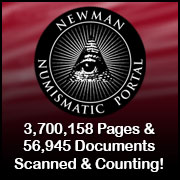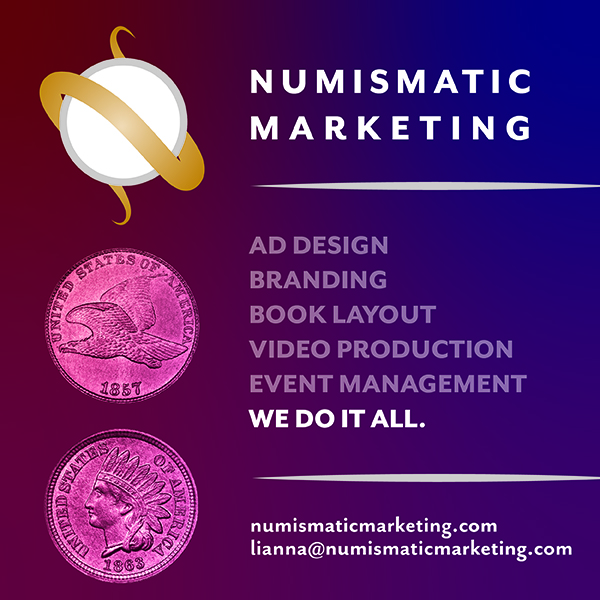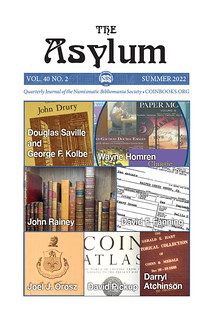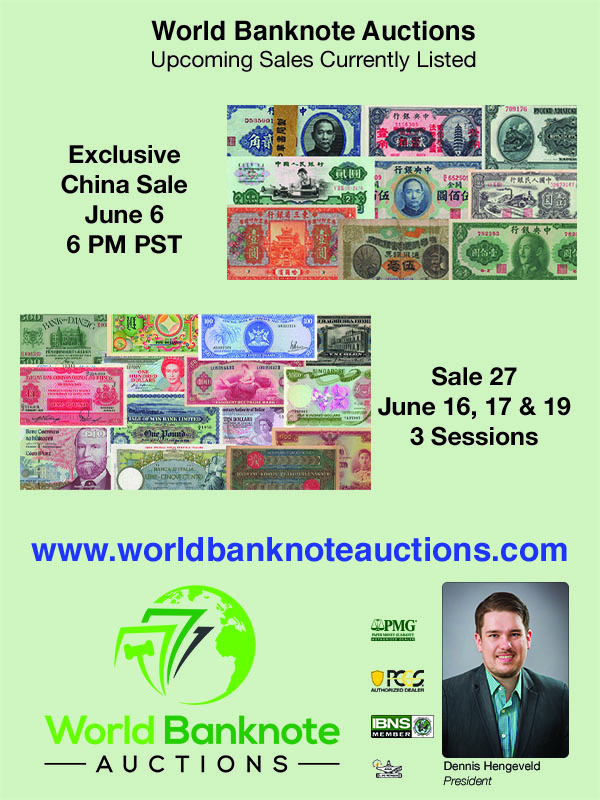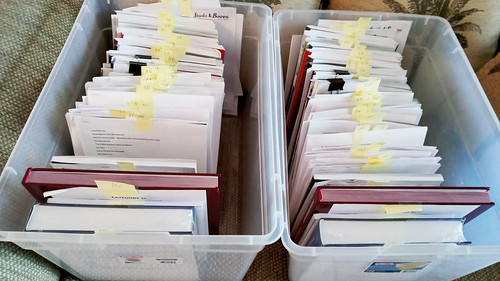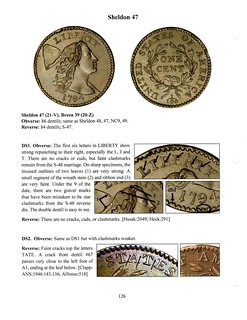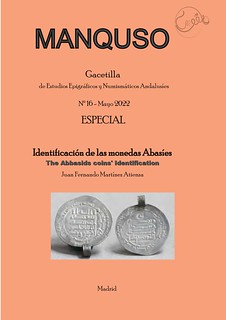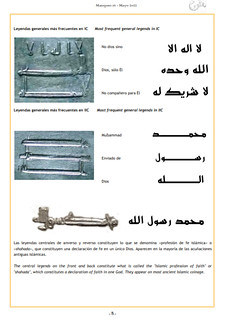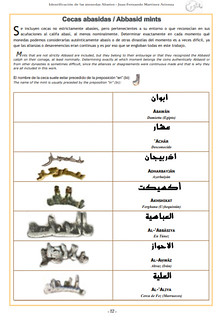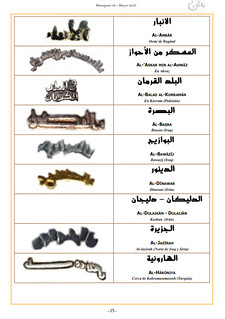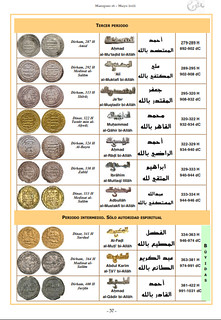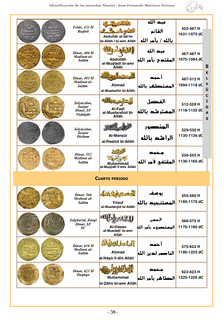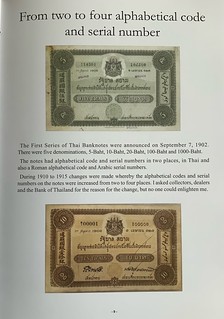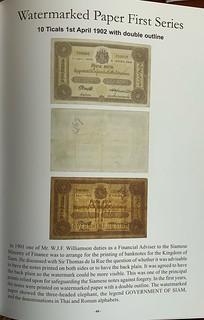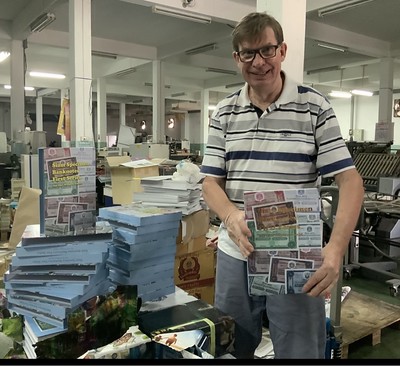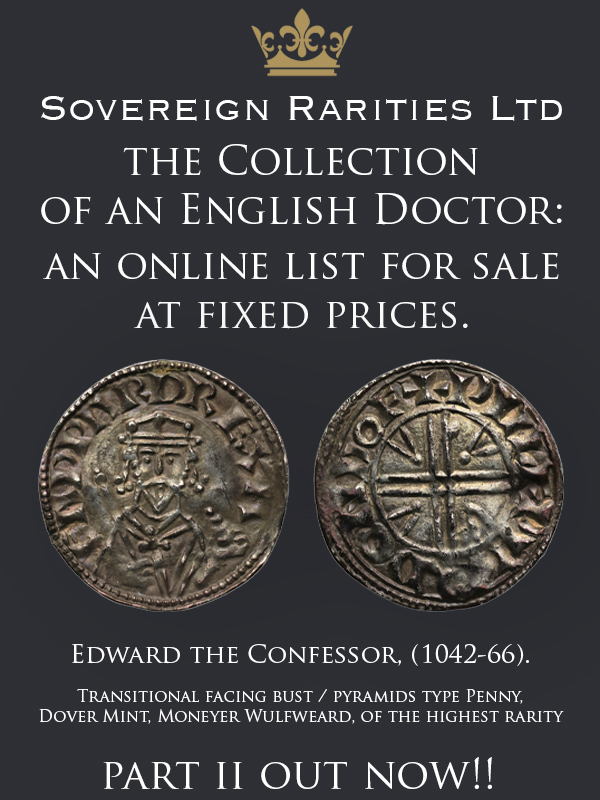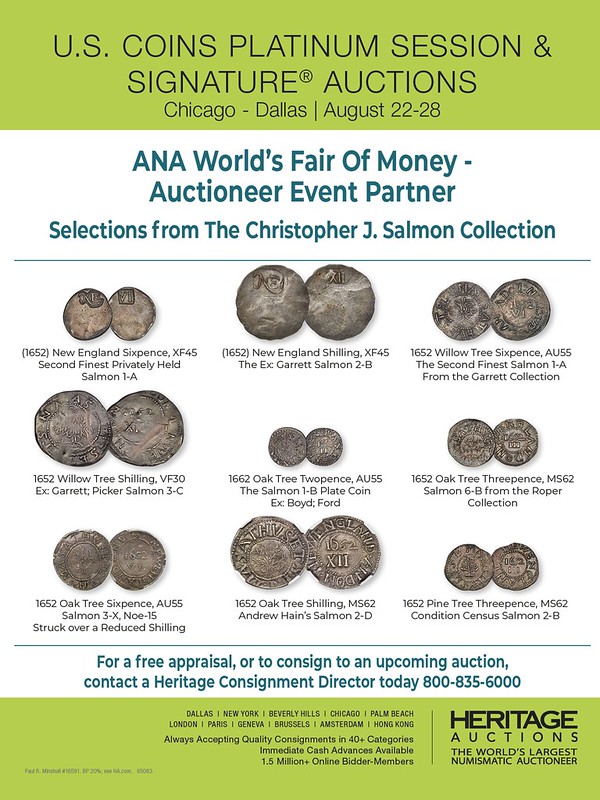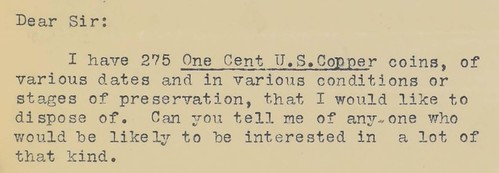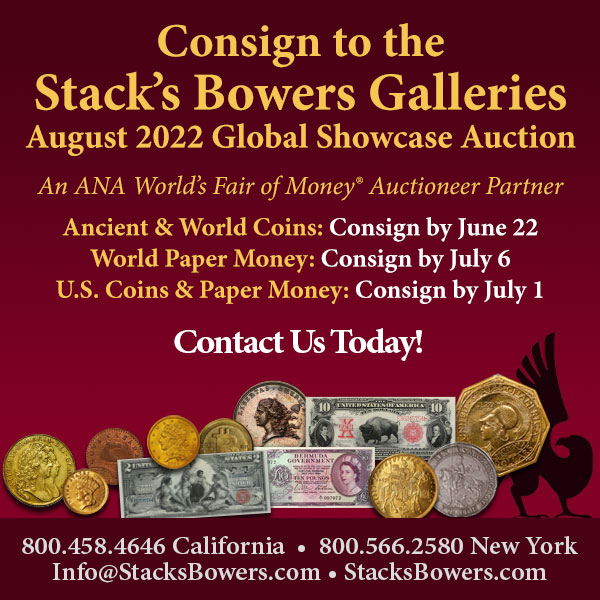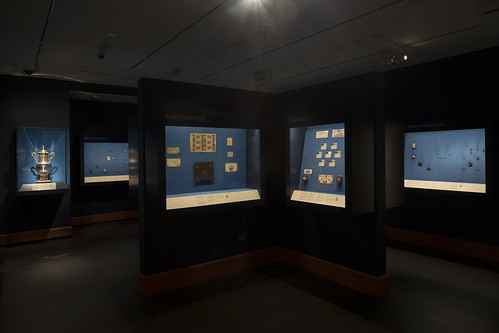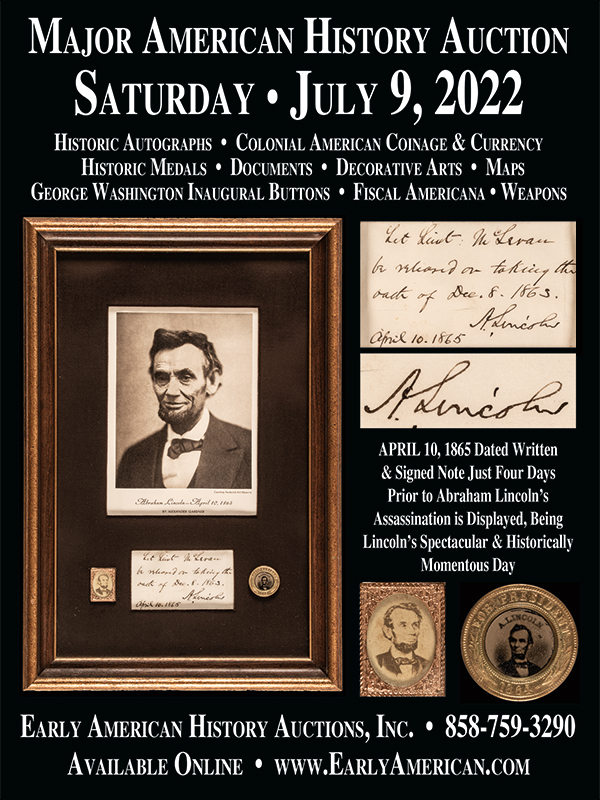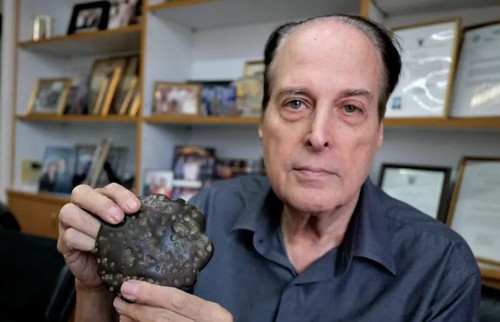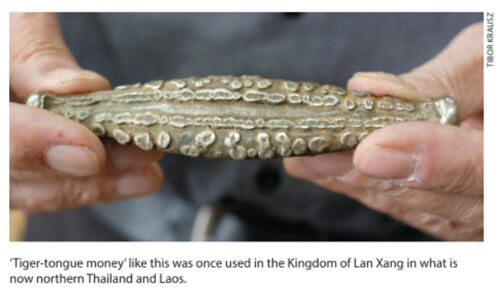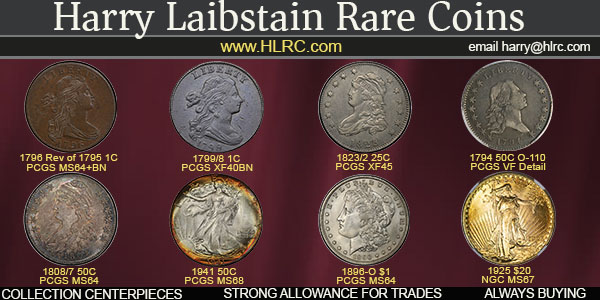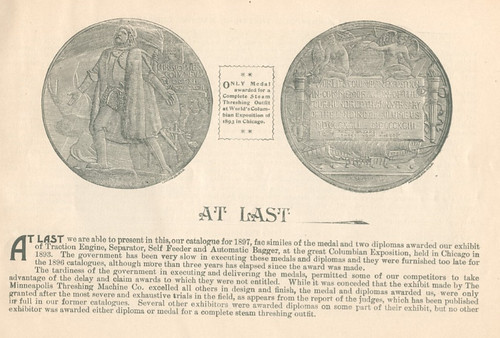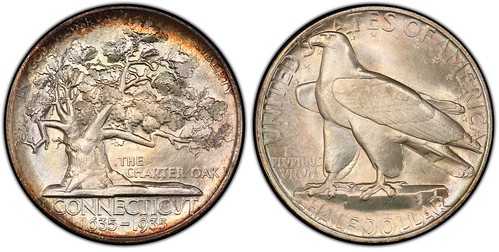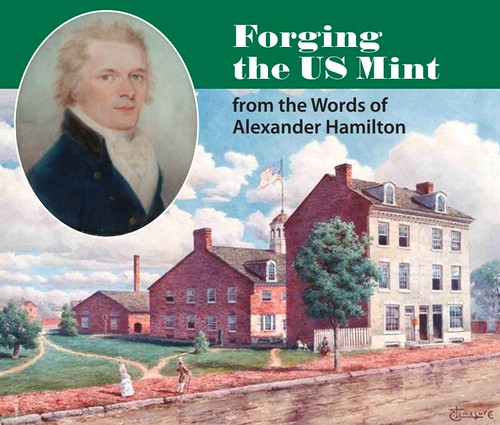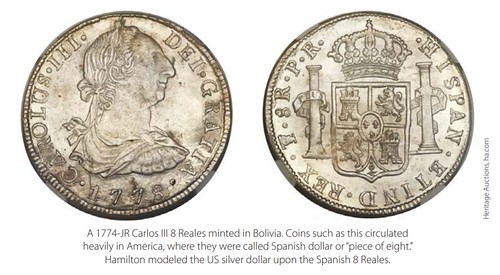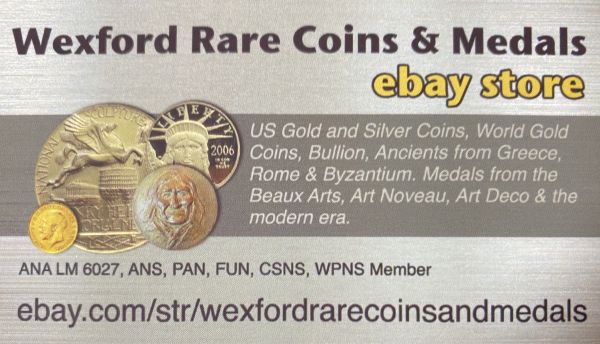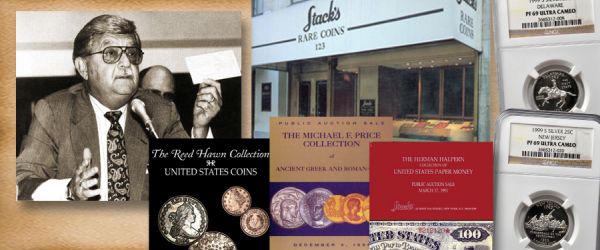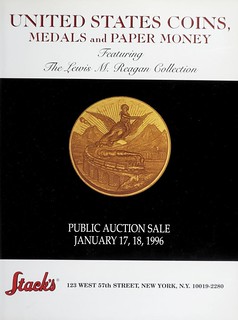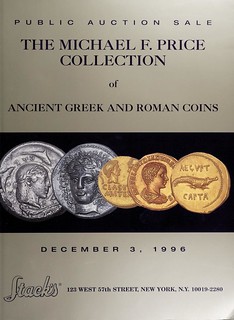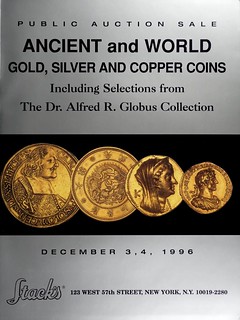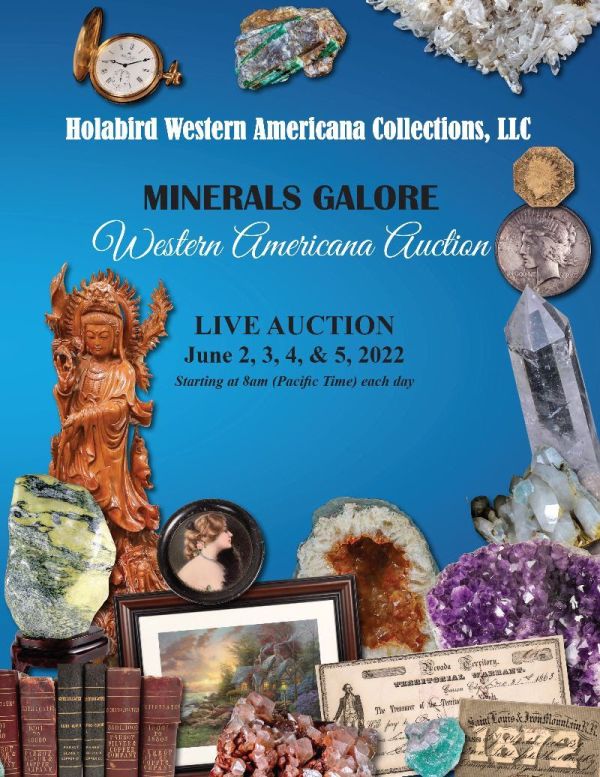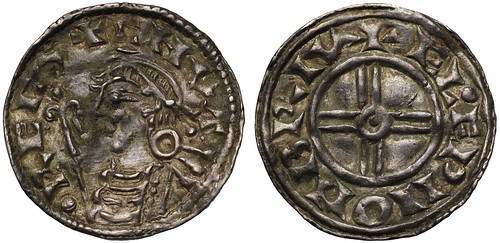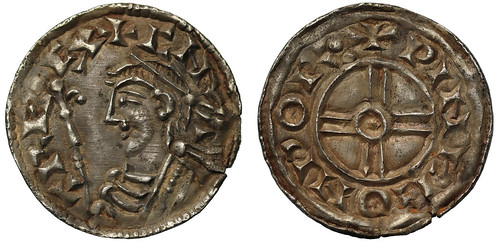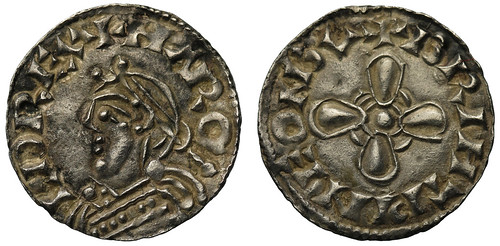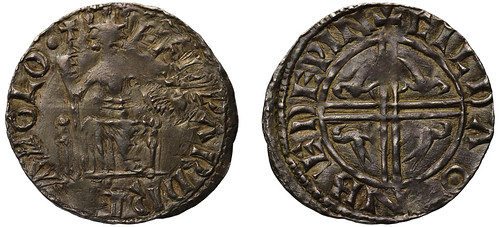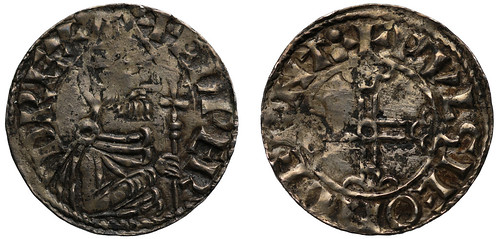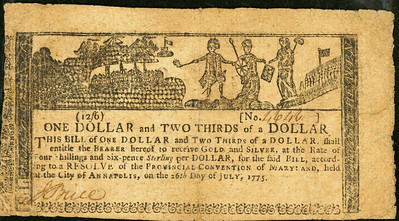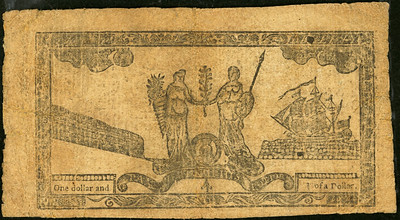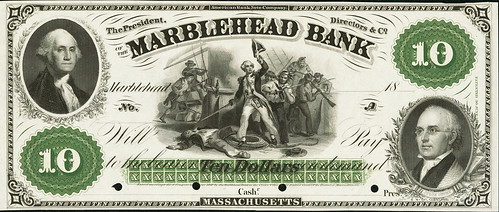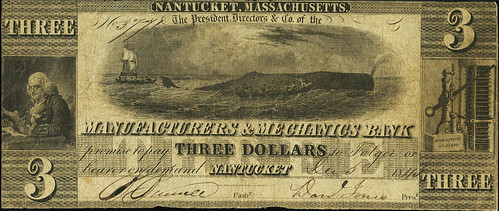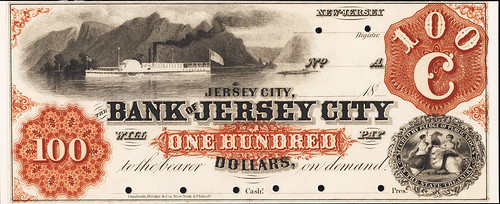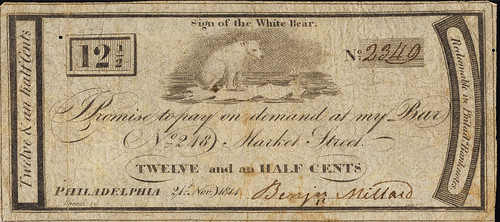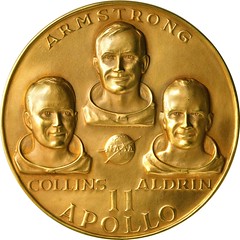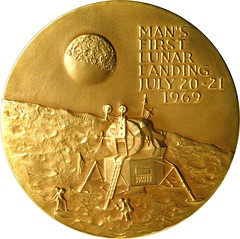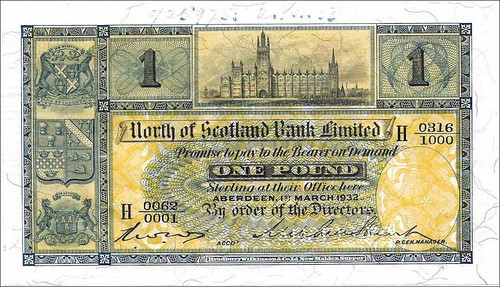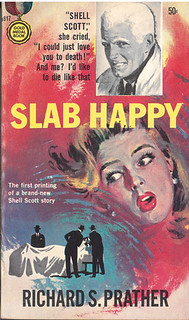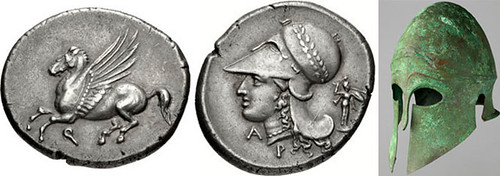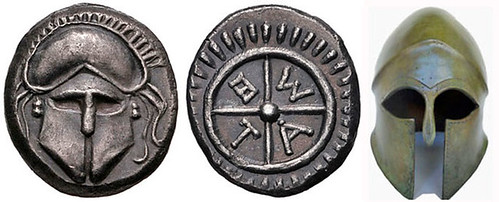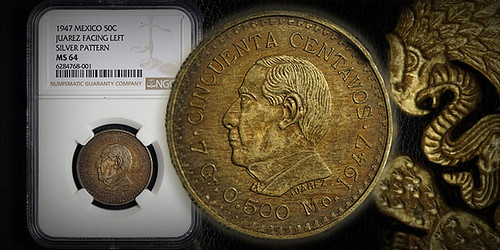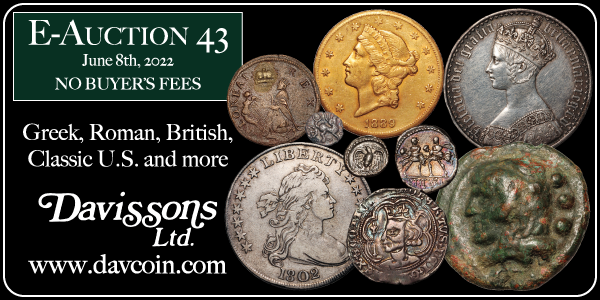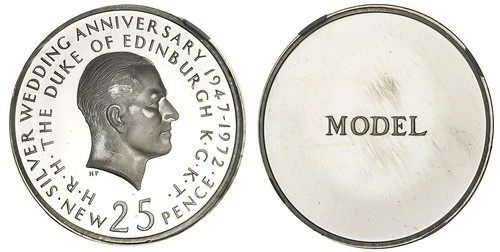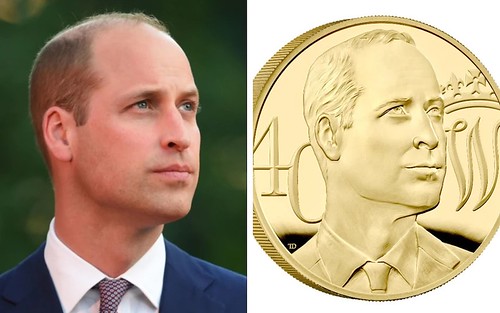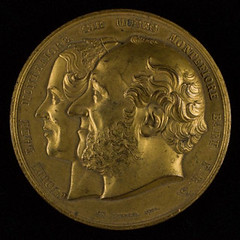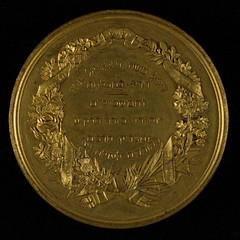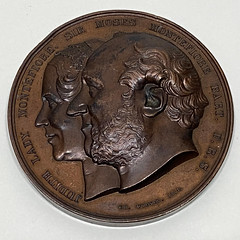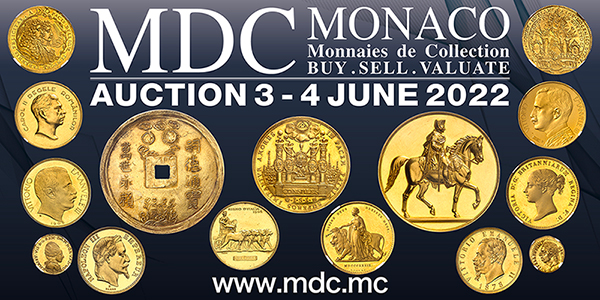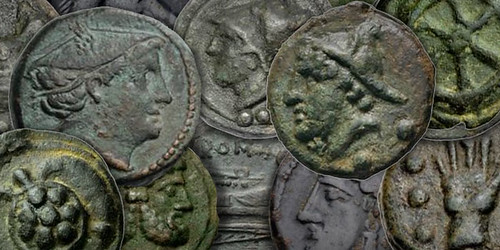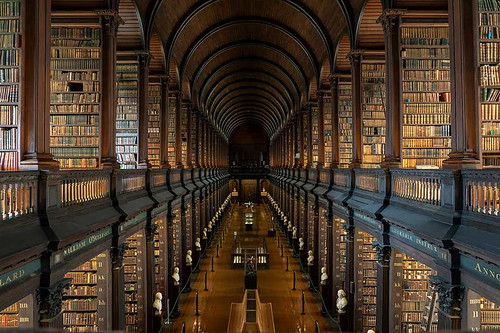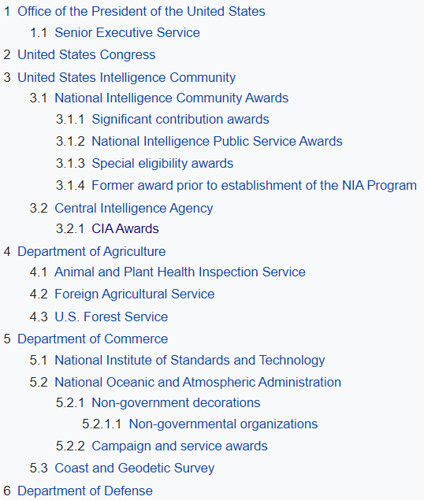
Visit our NBS Sponsors



About UsThe Numismatic Bibliomania Society is a non-profit association devoted to the study and enjoyment of numismatic literature. For more information please see our web site at coinbooks.org SubscriptionsThose wishing to become new E-Sylum subscribers (or wishing to Unsubscribe) can go to the following web page link MembershipThere is a membership application available on the web site Membership Application To join, print the application and return it with your check to the address printed on the application. Print/Digital membership is $40 to addresses in the U.S., and $60 elsewhere. A digital-only membership is available for $25. For those without web access, write to: Charles Heck, Treasurer AsylumFor Asylum mailing address changes and other membership questions, contact Chuck at this email address: treasurer@coinbooks.org SubmissionsTo submit items for publication in The E-Sylum, write to the Editor at this address: whomren@gmail.com BUY THE BOOK BEFORE THE COINSale CalendarWatch here for updates! |
- WAYNE'S WORDS: THE E-SYLUM MAY 29, 2022
- ASYLUM SUMMER 2022 ISSUE PUBLISHED
- NLG AWARDS COMPETITION DEADLINE JUNE 4, 2022
- NEW BOOK: DIE STATES OF 1794 LARGE CENTS
- NEW BOOK: IDENTIFICATION OF ABBASID COINS
- NEW BOOK: SIAM SPECIMEN BANKNOTES
- JULIAN BROOK
- NNP: LINDERMAN COLLECTION REMNANTS?
- VIDEO: CHINESE MILITARY PAYMENT CERTIFICATES
- NEWMAN GRANTS 2022 AWARD ANNOUNCEMENT
- YALE'S BELA LYON PRATT GALLERY OF NUMISMATICS
- GETTY PERSIA EXHIBIT
- RONALD CRISTAL: THE MONEY MAN OF SIAM
- NOTES FROM E-SYLUM READERS: MAY 29, 2022
- HAMILTON'S REPORT ON ESTABLISHMENT OF A MINT
- VOCABULARY TERM: INVERTED INSCRIPTION
- MARCEL JOVINE (1921-2003)
- HARVEY STACK'S NUMISMATIC FAMILY, PART 122
- COLLECTION OF AN ENGLISH DOCTOR, PART TWO
- MORE ON THE PLATINUM JUBILEE AUCTION
- THE HERITAGE LII COLLECTION CURRENCY SALE
- NUMISMATIC NUGGETS: MAY 29, 2022
- HELMETS ON ANCIENT GREEK COINS
- RARE MEXICAN SILVER PATTERN COIN SURFACES
- THE WHOLE TRUTH ABOUT THE PAGET ‘MODELS'
- FRASER'S WASHINGTON TURNS BACK ON GOD!
- REPORT: REMOVE CHIANG KAI-SHEK PORTRAITS
- PRINCE WILLIAM TO APPEAR ON £ 5 COIN
- LADY AND SIR MOSES MONTEFIORE MEDAL
- MEXICAN BANKNOTE'S ENDANGERED SALAMANDER
- LOOSE CHANGE: MAY 29, 2022
- FEATURED WEB PAGE: AWARDS AND DECORATIONS OF THE US
Click here to read the thin version on the web
Click here to subscribe
Click here to access the complete archive
To comment or submit articles, reply to whomren@gmail.com
Content presented in The E-Sylum is not necessarily researched or independently fact-checked, and views expressed do not necessarily represent those of the Numismatic Bibliomania Society.
WAYNE'S WORDS: THE E-SYLUM MAY 29, 2022
 New subscribers this week include:
Jan Olav Aamlid.
Welcome aboard!
New subscribers this week include:
Jan Olav Aamlid.
Welcome aboard!
Thank you for reading The E-Sylum. If you enjoy it, please send me the email addresses of friends you think may enjoy it as well and I'll send them a subscription. Contact me at whomren@gmail.com anytime regarding your subscription, or questions, comments or suggestions about our content.
This week we open with updates from NBS and NLG, three new books, updates from the Newman Numismatic Portal, and more.
Other topics this week include 1794 Large Cents, Julian Brook, Henry R. Linderman, Marcel Jovine, The Bela Lyon Pratt Gallery of Numismatics, Hamilton's Report on the Establishment of the Mint, auction previews, helmets on ancient coins, the Paget models, and Prince William's hair.
To learn more about D.R.D. Edmunds, the NLG annual Awards competition,
Abbasid coins, Siam Specimen Banknotes, Lewis M. Reagan, the Aes Grave,
tiger tongue money, slug dies, the Dead Man's Penny,
meadow muffin money and the numismatic author also known as
Victorious Warrior [with] Majestic Power
, read on. Have a great week, everyone!
Wayne Homren
Editor, The E-Sylum
ASYLUM SUMMER 2022 ISSUE PUBLISHED
The Summer 2022 issue of The Asylum is on the way from our sponsor, the Numismatic Bibliomania Society. Maria Fanning edits our print journal, and she submitted this report and President Tom Harrison's message. -Editor
The NBS's The Asylum's Summer 2022 Issue
Maria Fanning, editor
- David R. Drury Edmunds: An Appreciation By Douglas Saville
- Remembering D.R.D. Edmunds By George Kolbe
- BiblioFiles: Anthony R. Gonzales, Sr.
- Numismatic Literary Guild and Numismatic Bibliomania Society: Sister Organizations Devoted to Numismatic Literature By Wayne Homren
- Archbishop Sharpe's Observations on the Coins of England By Dr. John Rainey, MBE
- Walter Breen's Birthdate By David F. Fanning
- ASSOCIATIONS: Autographs • Annotations • Inscriptions Charles Ira Bushnell's Flandin's Catalogue of Coins and Medals: Part II, The Pierre Flandin Sale, June 6, 1855 Second Part of Part II By Joel J. Orosz
- The Coin Atlas Handbook: Somewhat Outdated but Still Useful and Fun By David Pickup
- The Lunatics Are Running the Asylum By Darryl A. Atchison
Message from the NBS President, Tom Harrison
Plans are underway for this year's NBS events at the ANA World's Fair of Money in Rosemont, Illinois. The convention will provide a number of opportunities for members to support the NBS and share their enthusiasm with fellow bibliophiles. The Symposium will feature our esteemed Treasurer, large cent authority Chuck Heck, discussing his new book Die States of 1794 United States Large Cents. Chuck will provide a fascinating behind-the-scenes look at the research and production of his book. Again this year, the NBS will be hosting our club table. We invite everyone to stop by and view a few of the highlights that will be offered in our charity auction, purchase an NBS commemorative coffee mug and share your mania for numismatic literature. Creating an exhibit is a wonderful opportunity to provide the greater community with the benefits of building a numismatic library.
Our General Meeting will feature The Asylum author awards and our charity auction. We are again grateful to David Fanning for graciously agreeing to accept and catalog items for this event. The auction will be held at the NBS General Meeting. While we appreciate all donations, we especially need items valued over $100. Please contact David at df@numislit.com before sending your donations. Donations can be sent to: David Fanning, 141 W. Johnstown Road, Gahanna, Ohio 43230 and should be received by June 30th. The charity auction helps provide the necessary funds for our award winning-journal, The Asylum, and the NBS bimonthly podcast. Thank you for your continued generous support of the NBS!
This year we would like to invite members to bring an item or two to share during an informal time at the conclusion of official business at the General Meeting. Bring a rare work, a special inscribed book or even a whimsical item. It will be fun to see what others bring, but the real goal is to provide a bit of social time to get better acquainted and meet other like-minded enthusiasts.
Please watch for further convention details in The E-Sylum as times and room assignments are confirmed. May your library provide investigation, discovery and most of all, enjoyment.
The Asylum Awards
NBS members can vote on The Asylum author awards: the Joel J. Orosz Award for best article of the year in The Asylum and the Jack Collins Award for the best article by a first-time author in The Asylum. Voting closes June 30, 2022.
Vote here: https://www.surveymonkey.com/r/5VMRZV5
Members - please be sure to vote. If you're not a member, what are you waiting for? Remember, while The E-Sylum is free to all, only paid members of the Numismatic Bibliomania Society receive our print journal, The Asylum. Print/Digital membership is $40 to addresses in the U.S., and $60 elsewhere. A digital-only membership is available for just $25. -Editor
To join NBS or renew your membership, see:
https://www.coinbooks.org/about/membership.html
NLG AWARDS COMPETITION DEADLINE JUNE 4, 2022
The Summer 2022 issie of The Asylum includes my new article about the differences between us (NBS) and our sister organization NLG. David Lange is coordinating NLG's annual Awards competition and he sends this reminder of the approaching submission deadline. -Editor
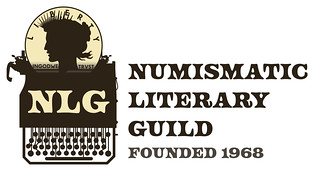 The deadline for submissions to the Numismatic Literary Guild's annual Awards competition is Saturday, June 4. As the Awards Coordinator, I'm attaching a couple of photos that reveal how many entries have already been received and sorted for our three judges. This work is performed at the Chateau Lange, and it appears that another bumper crop of literary and graphic brilliance has materialized.
The deadline for submissions to the Numismatic Literary Guild's annual Awards competition is Saturday, June 4. As the Awards Coordinator, I'm attaching a couple of photos that reveal how many entries have already been received and sorted for our three judges. This work is performed at the Chateau Lange, and it appears that another bumper crop of literary and graphic brilliance has materialized.
There are still just a few days left to collect entries, if any NLG members have permitted their minds their let that looming deadline escape their notice. Submitters are reminded that all entrants must be paid members of the NLG in good standing.
For more information, see the earlier E-Sylum article:
NLG 2022 AWARD COMPETITION
(https://www.coinbooks.org/v25/esylum_v25n11a16.html)
NEW BOOK: DIE STATES OF 1794 LARGE CENTS
As noted last week, NBS Treasurer Chuck Heck has published a great new book for Large Cent specialists. Here's the full announcement. -Editor
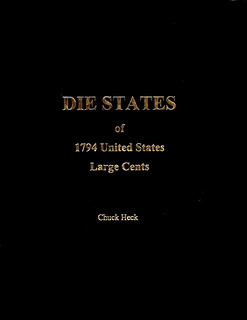 Chuck Heck introduced his new book, DIE STATES of 1794 United States Large Cents, at the Early American Coppers convention held in St. Louis from May 12 – 15. The 9x12 black hardcover book
contains 698 full color photos on 200 pages.
Chuck Heck introduced his new book, DIE STATES of 1794 United States Large Cents, at the Early American Coppers convention held in St. Louis from May 12 – 15. The 9x12 black hardcover book
contains 698 full color photos on 200 pages.
The Contents page shows the different approach
taken in this book. Heck has a Must Read First
section at the very beginning that provides the
reader with the rules of the game. What follows is a
look at how die states were treated by prior authors,
a story of what the US mint was experiencing back
in 1794, and a thorough examination of the different
types of die states.
Every coin is listed by Sheldon number, but the writing order follows the Breen emission sequence, except where Heck has found discrepancies. In one of several examples, Heck shows clearly why the order of S-66, 67, 68, 69 is not accurate and should be S-66, 68, 67, 69. Also, Heck admits that the puzzle concerning S-70 and 71 has not been completely solved and hopes that some unseen die states will soon be found to put his mind at peace.
Every variety begins with enlarged obverse and reverse photos, followed by die state characteristics that are fully described and illustrated with enlarged photos. Points of reference are indicated on the photos with arrows, circles, etc. when necessary. (See the sample page for Sheldon 47.)
Books can be obtained for $90 plus $7 for shipping and handling to destinations in the US. For complete information, contact Chuck at 1794Chuck@gmail.com.
NEW BOOK: IDENTIFICATION OF ABBASID COINS
"E-Sylum readers may find this online Abbasid coin identification publication of interest. It is well designed and handles complex issues with clarity."
Thank you. The 84-page book is in Spanish and English and is illustrated in color. Looks very useful. Here's the author's preface and some sample pages. -Editor
This writing was born as a personal work. My own interest prompted a guide to help me identify Abbasid coins. I soon understood that I needed help bring it to completion, this help was selflessly given to me from Federico. And that's how little by little it has grown to become the work you have in your hands.
A publication like this one involves many risks due to various factors.
On the one hand, we have that the Abbasid Caliphate lasted for 524 years, going through various historical periods, which means that we can see different styles of coinage, calligraphy and even the distribution of legends. We can add to this that there was a huge extension, since many of its territories acted almost autonomously and therefore issued differente currency than the official one.
The number of mints that issued coins at some point in the history of this Caliphate is enormous, here we have registered around two hundred, but surely some have been overlooked. Despite this we believe that the compilation is quite complete and that it will help those who use it.
It has been completed with some sections that allow deciphering the value and dates of the coins. It is a chapter in which all the caliphs are related to the years in which they ruled with an example of a coin from their reign so that the stylistic evolution of each period can be observed.
Finally, many of the names that appear on the coins are added: viziers, governors, rebels, etc.
So, it is a simple work, without great pretensions, a simple, very concise guide to a very broad historical period. For this reason, I apologize for the errors that I have made in its writing, but it is exposed to the public hoping it may be useful to the reader.
Juan Fernando Martínez Atienza
To read of download the book, see:
http://www.amuletosdealandalus.com/Manquso.com/
THE BOOK BAZARRE
NEW BOOK: SIAM SPECIMEN BANKNOTES
A new book has been published on Siam Specimen Banknotes. Author Jan Olav Aamlid provided these details. -Editor
 Siam Specimen Banknotes First Series
Siam Specimen Banknotes First Series
By Jan Olav Wilborn Aamlid
For many years I have worked on the book. I paid several visits to Thomas de la Rue at the De La Rue House in Basingstoke, Hampshire to go threw their archives. I met several times with the archivist Ray Marshall who for years have worked for de la Rue and got from him valuable information.
The collection of Specimen notes I have built up during the last 22 years. I have been collecting Thai Banknotes for about 40 years, but starting concentrating on Thai Specimen notes and artwork when de la Rue started selling from their archives. The banknotes are bought from Spinks auctions, other auction companies, directly from de la Rue and from private collectors.
The book is in A4 format, colours, hard cover and 246 pages. All the banknotes are pictured some with backlight so the watermark is visible.
There are several stories about the background of the banknotes; From two to four alphabetical code and serial numbers
, Watermarked paper First Series
, First Series Siamese Banknotes, trials and tribulations
, How the USA lost bid to print Siamese 1 Tical/Baht banknote
and Rare spelling errors detected in Siamese First Series Banknote
.
The book also contains original letters from the Ministry of Finance in Bangkok, The Siamese Legation in London and Thomas de la Rue & Company Limited concerning the printing of the banknotes.
104 banknotes, most of them specimens, are catalogued and described in the book.
The book can be bought/ordered from
In Thailand:
- From the author: jan@aamlid.no
- Eur-Seree: auction@eurseree.com
- Hobby inter: hobbyinter@gmail.com
In Norway:
- Oslo Myntgalleri: kontakt@oslomyntgalleri.no
- Riibe Mynthandel: mynt@riibe.no
In England:
- Spink UK: ehoward@spink.com
JULIAN BROOK
Numismatic Society of Auckland Secretary Jim Duncan submitted this announcement of the death of numismatist Julian Brook on May 15. Thank you. -Editor
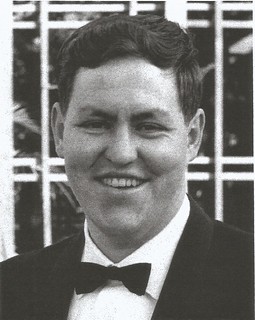 One of New Zealand's most learned and active numismatists has finally
been beaten by ill health. He was 86 years old.
One of New Zealand's most learned and active numismatists has finally
been beaten by ill health. He was 86 years old.
Julian was a pharmacist but he had a number of passions beside work - the movies, debating, numismatics to name but three. He was a founding and Honorary Member of the Numismatic Society of Auckland and a Fellow of the Royal Numismatic Society of New Zealand. He was also a 50-year member of the ANA.
He produced over a number of years a series of essays on "The Man on the Coin" which were published in Mintmark, magazine of the N.S.A. When it was announced that NZ would go decimal he contacted tellers in banks and on the Auckland Harbour Bridge to watch for quality old-style coins as they worked. He then circled weekly to see what they had accumulated.
His most significant numismatic contribution was the discovery and recording of the varieties of the 1935 Threepence - our rarest circulating piece - which had hitherto been unnoticed. The difference between the wide and narrow date digits was 0.014mm!
Julian has been bed-bound for over a year, so his passing must be a relief for his wife and children. He was the 17th Julian in his family since the 17th century - a fact he was extremely proud of - and why not? He served his city as a Justice of the Peace.
Julian will be greatly missed, for his encyclopedic knowledge, his demeanor, and willingness to help others.
NNP: LINDERMAN COLLECTION REMNANTS?
The latest additions to the Newman Numismatic Portal are letters from American Numismatic Society archives. Project Coordinator Len Augsburger provided the following report about one recently digitized letter. -Editor
Linderman Collection Remnants?
As part of the American Numismatic Society early correspondence scanning, Newman Portal recently processed a 1908 letter from M. H. Linderman to ANS President Archer M. Huntington, asking about disposing of a collection of 275 one cent U.S. copper coins, of various dates and in various conditions or stages of preservation.
The Linderman name is well known among numismatic historians, as Henry R. Linderman served as U.S. Mint Director from 1873 to 1878.
Pete Smith notes in American Numismatic Biographies
Linderman was a coin collector. His position gave him the opportunity to have pieces struck to order. He had an 1804 dollar in his collection that came directly from the mint. It sold for $470 to James Ten Eyck. His collection included a number of patterns. It was cataloged for sale by Lyman Low June 28, 1887. A dispute arose over the legality of some of the patterns and the collection was withdrawn from sale. It was finally sold February 28, 1888.
The 1887 sale included a substantial offering of pattern cents, along with the note the entire collection is here offered; not a single piece held back.
This entire sale was cancelled and offered again the following year, with a few pieces excepted. The cataloguer noted After mature consideration of all the questions of law and equity involved in the sale of trial and experimental pieces formerly classed as ‘pattern' pieces, made at the United States mint, the government has allowed us to sell the celebrated Linderman collection…
Again, this catalog included a good-sized offering of pattern cents.
If indeed these coins were from the Linderman family, one wonders if they were somehow more special than a random accumulation of pocket change.
Image: Extract of letter from M. H. Linderman to Archer M. Huntington, December 10, 1908
Link to Lyman Low June 28, 1887 sale of the Linderman collection:
https://archive.org/details/catalogueofvalua00lowl_2
Link to J. W. Scott February 28, 1888 sale of the Linderman collection:
https://archive.org/details/catalogueofvalua00scot_1
VIDEO: CHINESE MILITARY PAYMENT CERTIFICATES
These are selections from the David Lisot Video Library that feature news and personalities from the world of coin collecting. David has been attending coin conventions since 1972 and began videotaping in 1985. The Newman Numismatic Portal now lists all David's videos on their website at:
https://nnp.wustl.edu/library/multimediadetail/522852
Here's one on Chinese Military Payment Certificates and coupons of the Sino-Vietnamese war of 1979 with researchers Roger Urce and Howard Daniel. -Editor
2011 Memphis International Paper Money Convention
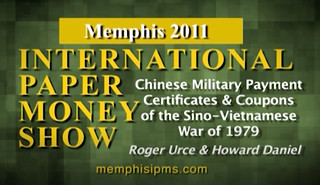 These two renowned military currency researchers take you on an unforgettable foray into the notes from the brief and bloody conflict of the Third Indochina War. Their talk is profusely illustrated with maps of the region and examples of the notes. In this video and PowerPoint presentation you will see and learn: * Three wars fought in Indo-China beginning with the French in the 1950's * Why the Chinese were at odds with the Vietnamese and fought a war * Examples of recently discovered notes for food rations * Military payment script for Chinese soldiers
These two renowned military currency researchers take you on an unforgettable foray into the notes from the brief and bloody conflict of the Third Indochina War. Their talk is profusely illustrated with maps of the region and examples of the notes. In this video and PowerPoint presentation you will see and learn: * Three wars fought in Indo-China beginning with the French in the 1950's * Why the Chinese were at odds with the Vietnamese and fought a war * Examples of recently discovered notes for food rations * Military payment script for Chinese soldiers
Speaker(s): Roger Urce & Howard Daniel.
David adds:
"In honor of Memorial Day and our American troops I have chosen a video by two veterans who fought in Viet Nam and have devoted their collector interest to bank notes and paper money of Indo China and that region. Roger Urce and Howard Daniel are two serious numismatic scholars and authors. They are also great guys to those who know them!"
The video is available for viewing on NNP at:
https://nnp.wustl.edu/library/book/560349
NEWMAN GRANTS 2022 AWARD ANNOUNCEMENT
Len Augsburger provided this announcement of the 2022 Newman Grants on May 25th, the birthday of the late Eric P. Newman. Some great projects outlined here. -Editor
Eric P. Newman Numismatic Education Society Announces Newman Grants
 The Eric P. Newman Numismatic Education Society (EPNNES) today announces its third set of Newman
Grants, created to financially assist numismatic authors and organizations pursuing original research in
American numismatics. Newman Grants are awarded annually on the late Eric P. Newman's birthday
and assist with direct costs of numismatic research such as travel, photography, and graphic arts
services.
The Eric P. Newman Numismatic Education Society (EPNNES) today announces its third set of Newman
Grants, created to financially assist numismatic authors and organizations pursuing original research in
American numismatics. Newman Grants are awarded annually on the late Eric P. Newman's birthday
and assist with direct costs of numismatic research such as travel, photography, and graphic arts
services.
Six awards are being made this year, touching on varied aspects of numismatics including colonial and federal coinage, numismatic literature, medals, and numismatics of World War II. The 2022 Newman Grant awardees are:
Ellen Anstey will conduct research regarding the development of the America the Beautiful Quarters Program (2010-2021). Anstey previously delivered a postgraduate thesis related to the State Quarters (1999-2008) series.
George Cuhaj will document medals issued by the Roman Catholic Church in the United States beginning in 1789. Cuhaj has previously published on this topic in The Numismatist and the TAMS Journal.
David Fanning will create a bibliography of the earliest photographically illustrated numismatic publications. Fanning has written widely on numismatic literature, including the 2020 monograph Ancient Coins in Early American Auctions, 1869-1939.
Steve Feller and Ray Feller will investigate internment camp money of the United States during World War II. This father-daughter team are the authors of Silent Witnesses: Civilian Camp Money of World War II (2007), which explored money and scrip used in concentration camps and ghettos.
Jesse Kraft is the Assistant Curator of American Numismatics at the American Society and will travel to Europe to study archival resources related to the engraver Elias Gervais and his possible involvement with the Continental Dollar.
Ángel O. Navarro Zayas will study efforts to introduce copper coinage into 18 th century Spanish America. Zayas has recently published material from the Archivo General de Indias in Seville, Spain, and other repositories, in The Numismatist and The Journal of Early American Numismatics.
It is the hope of EPNNES that this program will continue the legacy of Eric P. Newman in a way that would reflect his high standards for numismatic research.
To read the earlier E-Sylum article, see:
2022 NEWMAN GRANT PROGRAM ANNOUNCED
(https://www.coinbooks.org/v25/esylum_v25n09a10.html)
YALE'S BELA LYON PRATT GALLERY OF NUMISMATICS
Sorry for the delay in publishing this announcement - I was awaiting images, and they were worth waiting for. The new Bela Lyon Pratt Gallery of Numismatics at Yale looks marvelous. -Editor
Installation view of the Bela Lyon Pratt Gallery of Numismatics, Yale University Art Gallery. In the foreground, American Bank Note Company Collage, 1880-99, Ink on paper collage, Promised gift of Susan G. and John W. Jackson, B.A. 1967, and the Liana Foundation.
On May 13, the Yale University Art Gallery opened the new Bela Lyon Pratt Gallery of Numismatics. The first-floor gallery has been specially designed to exhibit the depth and breadth of the numismatics collection, featuring over 260 of the museum's smallest objects in 16 newly designed display cases. On view is numismatic artwork dating from the second millennium B.C. to the modern era.
The gallery has been divided into three sections and features numerous iconic objects and rarities alike, ranging from a Syracusan dekadrachm of the fourth century B.C., widely regarded as among the greatest artistic achievements of Greek coinage, to the Nobel Prize Medal for Literature awarded to Eugene O'Neill in 1936, as well as an unique American Bank Note Company collage (late 19th century). As the first designated and custom-designed public gallery for this material at Yale, it marks a watershed moment in the history of one of the oldest collections at the University and reflects the museum's commitment to emphasizing the importance of this often-overlooked field of the arts.
NOTE FROM THE CURATOR
The Yale University Art Gallery is proud to welcome visitors to the new Bela Lyon Pratt Gallery of Numismatics, opening May 13. The first-floor gallery has been specially designed to exhibit the depth and breadth of the numismatics collection, featuring over 260 of the museum's smallest objects in 16 newly designed display cases. On view is numismatic artwork dating from the second millennium B.C. to the modern era.
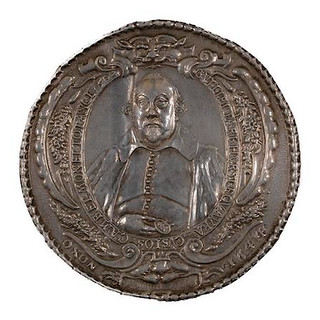 The installation offers a beautifully rich introduction to an often-overlooked area of the arts, including iconic pieces and rarities. Among the objects on display is a remarkable and highly sought-after silver medal of Sir William Parkhurst (1644) by Thomas Rawlins, one of the greatest medalists. The solemn portrait of Parkhurst as Warden of the Exchange and Mint of England for Kings James I, Charles I, and Charles II demonstrates Rawlins's extraordinary hand. In the intimate new gallery, visitors can quietly study this and other breathtaking numismatic masterpieces.
The installation offers a beautifully rich introduction to an often-overlooked area of the arts, including iconic pieces and rarities. Among the objects on display is a remarkable and highly sought-after silver medal of Sir William Parkhurst (1644) by Thomas Rawlins, one of the greatest medalists. The solemn portrait of Parkhurst as Warden of the Exchange and Mint of England for Kings James I, Charles I, and Charles II demonstrates Rawlins's extraordinary hand. In the intimate new gallery, visitors can quietly study this and other breathtaking numismatic masterpieces.
Benjamin Dieter R. Hellings
The Jackson-Tomasko Associate Curator of Numismatics
Ben adds:
"I'm delighted with our new permanent numismatics gallery and how it turned out. It demonstrates the Art Gallery's commitment to numismatics and I hope many take the opportunity to come visit us."
To read the complete article, see:
https://artgallery.yale.edu/numismatics
GETTY PERSIA EXHIBIT
This Los Angeles Times review of a new exhibit at the Getty includes coins and medals on loan from the American Numismatic Society. -Editor
What propaganda used to be is on glamorous display in an exquisitely crafted silver plate that anchors the final room of Persia: Ancient Iran and the Classical World,
a new exhibition at the Getty Villa in Pacific Palisades. Made in Constantinople around A.D. 629-630, a period when the Eastern Roman power of Byzantium had surprisingly prevailed in a war against Persia's Sasanian Empire, the nearly 20-inch plate features an elaborate bas-relief that means to help cement the triumph. In three registers, it tells the story of David and Goliath.
David is a stand-in for Heraclius, the relentlessly warring Roman sovereign. Goliath is the bigger, older, more powerful representative of Persia, established for a thousand years. At the top, the two agree to fight as a bemused river god looks on.
In the center, the widest of the three registers, the bout has begun. Goliath has his spear and big shield raised, while David has loaded his slingshot and is waving a distracting cloak in his opponent's face. How things might go from here is suggested by the soldiers arrayed behind the two combatants: David's duo stand upright and firm, Goliath's are turning and lean away, ready to bolt.
In the bottom register comes the dénouement: David hacks off tumbling Goliath's head, presumably with his own sword. Framing them, the giant's big pile of scattered weapons at the right dwarfs the winner's little sling and three small rocks at the left.
The exhibition's fine catalog, prepared by Getty director Timothy Potts and curators Jeffrey Spier and Sara E. Coles, draws a notable historical conclusion. Heraclius, in his bloody Byzantine victory over Persia, is thought to have beheaded the Sasanian commander. That would make the silver plate a pretty specific allegory for the Eastern Roman emperor as God's designated champion on earth, like David, the victorious underdog in the struggle against the Philistine giant.
The show is divided into three sections, each focused on a different Persian empire. The Achaemenid (550-330 BC), founded by Cyrus the Great and expanded by Darius I, kicked things off and grew to encompass 2 million square miles — all the way from the Balkans to the Indus Valley. It was the largest empire ever, until Greece's Alexander the Great arrived with his armies and busted things up.
Impressive loans have come from the Louvre in Paris, the British Museum in London, the Oriental Institute in Chicago and elsewhere. The David and Goliath plate is from New York's Metropolitan Museum of Art.
Lions and bulls were featured on early Achaemenid coins, but a small gold disk announces a shift: A kneeling archer is the figure of Darius I, whose likeness on the chunky little coin asserts his position as the source of ultimate power. The tiny coin is just over a half-inch wide — 8.36 grams of gold, worth about $500 today — and it's but one of dozens of coins, seals and carved gemstones in the show.
They're small but fascinating, stylistically changing records of dynasties, rulers, events and timetables of history. Scholars use them to identify all manner of things, like portraits of luminaries and festivals. The Getty has installed touchpads adjacent to each display of groups of them, which lets a viewer examine the object in closeup and access more information.
To read the complete article, see:
Review: A small but strong display of ancient agitprop from Persia comes to the Getty Villa
(https://www.latimes.com/entertainment-arts/story/2022-05-27/persia-ancient-iran-getty-villa)
RONALD CRISTAL: THE MONEY MAN OF SIAM
Howard Daniel passed along this Jerusalem Post article about a numismatic author in Thailand. Thanks! -Editor
As a general rule, buffalo droppings aren't worth all that much, but the one Ronald Cristal is holding in his hands at his Bangkok office cost the Brooklyn-born Jewish lawyer a pretty penny when he acquired it at a sprawling weekend market in the Thai capital.
Should he choose to resell it, he could do so for around 100,000 baht, or $3,000.
There is a good reason for what may seem like a rather steep price for the black, badly pockmarked object that resembles a large, chunky beer coaster with a mangled rim. Despite its name, the buffalo dropping
in Cristal's hands has nothing to do with the bowel movements of water buffalo, those lumbering beasts of burden ubiquitous in parts of rural Southeast Asia.
To be sure, the 772-gram piece does bear more than a passing resemblance to meadow muffins deposited underfoot by incontinent ungulates, but it is a type of money that was in use in the 17th and 18th centuries in Luang Prabang, a quaint town in the mountains of northern Laos, which was then the capital of a small kingdom. This antique currency is made of pure copper, but what makes it valuable for Cristal, an avid numismatist, is its rarity.
You very rarely see them,
says Cristal,
80, a naturalized citizen of Thailand who also
goes by Ronachai Krisadaolarn, his adopted moniker that means Victorious Warrior [with] Majestic Power
If you buy one old coin a week, in 50 years
you get a big collection,
he observes apropos
of that collection, which he continues to ex-
pand any chance he gets. If there's something
I don't have, I'll buy it, but these days it's very
hard to find something I don't already have.
Cristal is managing director of Bangkok
International Associates, a firm specializing
in corporate and commercial law, where his
desk is cluttered with prints of antique coins
shuffled among files on legal cases. One
minute you'll find him scrolling through his
computer with meticulously cataloged photos
of peculiarly shaped tokens, ingots and coins.
The next he'll dash out from a room, only to
return with an item he has just retrieved from
a hefty safe to show you.
The minute after that, he'll fetch his authoritative reference guide on indigenous Thai
primitive money
– titled somewhat abstrusely to the uninitiated as Siamese Coins: From
Funan to the Fifth Reign – and flip open its
glossy pages here or there to yet more photographs. His magnum opus follows his two earlier books, The Centenary of Thai Banknotes
and The Coins and Medals of the Rattanakosin
Era (the royal dynasty from 1782 to date), both
of which are standard volumes of Siamese numismatics published respectively by the Bank
of Thailand and the Thai Treasury Department.
These seminal works have bolstered Cristal's claim to be the world's leading expert on
premodern forms of money from Siam, which
even in the esoteric world of numismatics
makes for an exotic field. Thailand is unique
in the history of coinage because no other place
on Earth has had such a diversity in coins,
Cristal explains.
 Cristal has another surprise in store. From
his safe he retrieves a tray on which are nickel-sized objects featuring the Star of David
symbol inside a dotted circle, in a design that
resembles a wheel with hexagram-shaped
spokes. The tokens hail from the Kingdom of
Ayutthaya, north of Bangkok, whose cosmopolitan, religiously tolerant milieu appealed to
the Jewish merchants who began visiting and
settling there as early as the 17th century.
Cristal has another surprise in store. From
his safe he retrieves a tray on which are nickel-sized objects featuring the Star of David
symbol inside a dotted circle, in a design that
resembles a wheel with hexagram-shaped
spokes. The tokens hail from the Kingdom of
Ayutthaya, north of Bangkok, whose cosmopolitan, religiously tolerant milieu appealed to
the Jewish merchants who began visiting and
settling there as early as the 17th century.
Were these coins made and used by the Jewish residents of the Siamese city? There was
a Jewish presence in Ayutthaya and there's a
whole box of these coins. Presumably the Jewish merchants made them.
Beyond that, nothing much is known about them.
Howard adds:
"I thought readers might find this to be an interesting article. I have known him for about 40 years and he has assisted me many, many times. I can forward the complete article to anyone who wants it."
To read the complete article (subscription required), see:
Ronald Cristal: The Jewish money man of Siam
(https://www.jpost.com/jerusalem-report/article-707110)
NOTES FROM E-SYLUM READERS: MAY 29, 2022
Minneapolis Threshing Machine Columbian Exposition Medal
Dave Baldwin writes:
"I sent the article about the insert die to a friend who has an interest in the Columbian Exposition Medals, specifically one awarded to the Minneapolis Threshing Machine Co. He sent back a company item about the delay in getting the medal. Thought the readers might find this interesting. And as a side note he would love to find that medal if it still exists, so if anyone has knowledge about this they can contact me."
Thanks. The materials also included an image of the certificate accompanying the medal (not reproduced here). -Editor
To read the earlier E-Sylum articles, see:
VOCABULARY TERM: INSERT DIE
(https://www.coinbooks.org/v25/esylum_v25n20a12.html)
MORE ON INSERT DIES
(https://www.coinbooks.org/v25/esylum_v25n21a07.html)
Slug Dies and the Dead Man's Penny
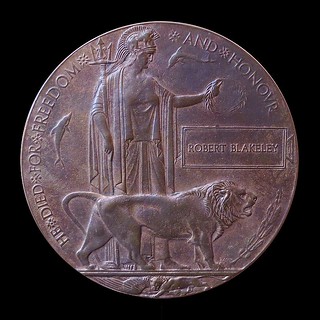 Regarding "Insert dies",
Rex Stark writes:
Regarding "Insert dies",
Rex Stark writes:
"If I'm not mistaken, these were also known as "slug dies".
"No doubt the referenced Columbian Expo award medals constituted the most extensive use of insert dies in this country. I bought one years ago with the insert named to "MR. STARK".
"By far the largest number of medals made in this fashion were the British WWI memorial plaques. More than 1.3 million were struck."
Thank you. Linked are an earlier E-Sylum article and Wikipedia entry on the WWI Memorial Plaques or Medallions - also known as the "Dead Man's Penny". -Editor
To read the complete article, see:
Memorial Plaque (medallion)
(https://en.wikipedia.org/wiki/Memorial_Plaque_(medallion))
To read the earlier E-Sylum articles, see:
THE DEAD MAN'S PENNY
(https://www.coinbooks.org/esylum_v09n46a16.html)
VOCABULARY TERM: INSERT DIE
(https://www.coinbooks.org/v25/esylum_v25n20a12.html)
MORE ON INSERT DIES
(https://www.coinbooks.org/v25/esylum_v25n21a07.html)
Bauman Belden's U.S. Lifesaving Medal Research
Regarding Roger Burdette's question about Bauman Belden's 1930 research at the Philadelphia Mint,
American Numismatic Society Librarian writes:
"I happen to be writing an article on this very topic. In 1929-1931 Belden was compiling a catalog of U.S. lifesaving medals. He died in August 1931 before it could be published. He was probably working on that."
Roger writes:
"Thanks to David for the info!
"Many lifesaving medals are mentioned in RG104 E-1 and E-235 from Philadelphia and College Park NARA respectively. They are also described in the various medal lists in E-105, 107 and 111 at Philadelphia NARA."
Thanks, everyone. -Editor
To read the earlier E-Sylum article, see:
NOTES FROM E-SYLUM READERS: MAY 22, 2022 : Belden's 1930 Philadelphia Mint Research
(https://www.coinbooks.org/v25/esylum_v25n21a08.html)
The Republic of New Atlantis
Dick Hanscom writes:
"I very much enjoyed the articles on Emperor Norton. I have "followed" issues from fantasy and micro nations. I find them amusing and entertaining, and have issued a few of my own.
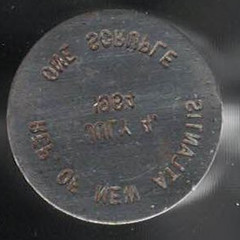 "While reading an article (on MSN) about the Republic of Minerva, they mentioned the Republic of New Atlantis. This struck a chord with me as I purchased a die for the RNA, denominated One Scruple and dated July 4, 1964. It is 22mm in diameter.
"While reading an article (on MSN) about the Republic of Minerva, they mentioned the Republic of New Atlantis. This struck a chord with me as I purchased a die for the RNA, denominated One Scruple and dated July 4, 1964. It is 22mm in diameter.
"The mention of the RNA stated, "The name was ubiquitous. The "Republic of New Atlantis" arose, albeit briefly, in 1964 when Ernest Hemingway's younger brother Leicester parked an 8-by-30-foot bamboo raft, anchored to an old Ford engine buried in the sand, 8 miles off the coast of Bluefields, Jamaica." The younger brother of Ernest Hemingway? Just too much fun.
"Of course I then had to Google the Republic of New Atlantis. There are several sites that describe the establishment and demise of the RNA. The story gets even better!
"Scan of the face of the die is attached. An image search does not find a product from this die."
Thanks. Searches of the Newman Portal and the E-Sylum archive do not turn up a reference to New Atlantis. -Editor
Jeff Shevlin posted on his website a copy of the article he and Bill Hyder published in the October, 2021 issue of The Numismatist about the Bashlow/Dickeson dies. -Editor
To read the Numismatist article, see:
http://www.so-calleddollar.com/wp-content/uploads/2022/05/Article-The-Other-Continental-Dollar-Oct-2021-The-Numismatist-1.pdf
To read the earlier E-Sylum article, see:
NOTES FROM E-SYLUM READERS: MAY 22, 2022 : The Other Continental Dollar
(https://www.coinbooks.org/v25/esylum_v25n21a08.html)
More on U.S. Classic Commemoratives
"I enjoyed Dave Bowers' recollections about the Rise and Fall of the U.S. Classic Commemorative Market. Fortunately, I had "stepped away" from collecting back in 1990 (due to parenthood, or diaper $$$) and missed out on some real roller coaster prices. Too many "new faces" always seem to upset markets, which I believe was caused from the interest of the newly-revived modern commemorative coinages of the 1980's. Classic commemoratives have always been a lively field but the buyer gets a lot out of them, such as low mintages, beautiful medallic art, and a good number of issues thrown into mass circulation which gives plenty of room for grading.
"A favorite book of mine remains Anthony Swiatek and Walter Breen's Silver & Gold Commemorative Coins. Although published in 1981, the highly controversial "Investment Section" at the back of the book brazenly forecasted 1990 prices. As an example, it listed the 1935 Connecticut at $2300 while the Red Book showed $2000. Not bad, but many other issues weren't even in the ballpark. The series will always have its spikes and dips, but a dedicated collector base makes up a strong foundation. About two years ago I achieved my goal of forming a complete silver type set in mint state, and enjoyed every dollar of it.
"The good news here is that commemoratives are relatively stable compared to Bitcoin, not to mention the current housing market."
To read the earlier E-Sylum articles, see:
COMMEMORATIVE MARKET RISE AND FALL, PART 1
(https://www.coinbooks.org/v25/esylum_v25n19a30.html)
COMMEMORATIVE MARKET RISE AND FALL, PART 2
(https://www.coinbooks.org/v25/esylum_v25n21a24.html)
Jewish Presentation Medal Sale Rescheduled
Michael Oppenheim of Vancouver writes:
"The auction of gold and silver Jewish presentation medals that earlier appeared in the May 8 edition of E-Sylum has been rescheduled. The gold 1926 Boston Fire Chief's badge engraved to Louis B. Mayer will be in the Ira and Larry Goldberg Collectibles Auction June 1-2, lot 150. Medals given to Jack Benny, Leonard Bernstein, George Meany, Barbara Jordan and others will be in Goldberg's Pre-Long Beach Auction #128 on June 26 (Lots 317-323). "
To read the earlier E-Sylum article, see:
JEWISH PRESENTATION MEDALS
(https://www.coinbooks.org/v25/esylum_v25n19a34.html)
Coinage and Congress
Lev Messick writes:
 "Well, I do really like the design for the Miss Liberty coin here. She does look a lot like the nice French immigrant lady who graces New York Harbor. No problem with that! France was America's first ally and the design is classic. Think of the millions of tired, hungry, poor, and oppressed persons who have come here and knew when they saw her that they had reached the promised land. I think that rather than politicians we should see more of Miss Liberty on our coinage. This design needs to be passed along to the Treasury Secretary. Ideas like this tend to roll downhill. Otherwise the mint would probably ignore it."
"Well, I do really like the design for the Miss Liberty coin here. She does look a lot like the nice French immigrant lady who graces New York Harbor. No problem with that! France was America's first ally and the design is classic. Think of the millions of tired, hungry, poor, and oppressed persons who have come here and knew when they saw her that they had reached the promised land. I think that rather than politicians we should see more of Miss Liberty on our coinage. This design needs to be passed along to the Treasury Secretary. Ideas like this tend to roll downhill. Otherwise the mint would probably ignore it."
Of course. The Mint takes its direction from Congress. It's fun to speculate, but making things happen requires getting attention and action from Congress, and that's never easy. -Editor
To read the earlier E-Sylum article, see:
EXTENDING THE PRESIDENTIAL DOLLAR SERIES
(https://www.coinbooks.org/v25/esylum_v25n21a10.html)
HAMILTON'S REPORT ON ESTABLISHMENT OF A MINT
An article by Eric Brothers in the Spring 2022 issue of Financial History from the Museum of American Finance is titled "Forging the US Mint From the Words of Alexander Hamilton." Here's an excerpt. -Editor
The coins that numismatists cherish
today are the result of the restless intellect
and tireless efforts of Treasury Secretary
Alexander Hamilton (1757–1804). He single-handedly embarked upon a financial
revolution that has greatly influenced the
US economy to this very day. An integral
element of that revolution was his Report
on the Establishment of a Mint
(hereafter
‘the Report'), submitted to Congress on
January 28, 1791, which served as the blueprint for the forging of the US Mint. In
essence, his words—his rhetoric—became
brick and mortar, offices and machinery,
officers, engravers and workers.
Financier Robert Morris put forth in Congress a plan for coinage and a mint in 1782,
though the specifics were formulated by his
assistant, Gouverneur Morris. Their plan
averaged the currency of 12 states into a
unit valued at 1/1440th of the Spanish dollar
and included coins in the denomination of
5, 8, 100, 500 and 1,000 units. In response
to Morris, Thomas Jefferson authored
his Notes on Coinage
in 1784. Employing straightforward language, Jefferson
methodically presented the practicality of
a decimal coinage, described the flaws in
Morris's plan and made suggestions that he
hoped would quicken the process of creating a national mint. However, it was not
until April 15, 1790, that Congress requested
Secretary Hamilton prepare a formal plan
for establishing a national mint.
Hamilton's Report was an ambitious undertaking. In his introduction, he presented the myriad complexities involved in conceiving and developing a national mint from scratch. He wrote:
A plan for an establishment of this nature involves a great variety of considerations…. The general state of Debtor and Creditor; all of the relations and consequences of price; the essential interests of trade and industry; the value of all property; the whole income both of the State and of individuals are liable to be sensibly influenced, beneficially, or otherwise, by the judicious, or injudicious regulation of this interesting topic.
The Report is a verbose, complex work
that is essentially a lecture that was written down. Hamilton proposed a question,
vis-à-vis the existing monetary system in
the United States, whether it may not
be most advisable to leave things, in this
respect, in the state in which they are. Why
might it be asked…should alterations be
attempted, the precise effect of which cannot with certainty be calculated?
Answering his own question, Hamilton
cited immense disorders
that were everpresent in the contemporary American
economy, including the debasement and
depreciation of the dollar to the tune of
5%, which lowered the value of all property. And since much of the circulating
specie of the day was foreign, states the
Report, Nor can it require argument to
prove, that a nation ought not to suffer
the value of the property of its citizens to
fluctuate with the fluctuations of a foreign
Mint, and to change with the changes in
the regulations of a foreign sovereign.
The Report also discusses the unequal
values allowed in different parts of the
Union to coins of the same intrinsic
worth…
—coinage of different denominations and values produced in the 13
individual states under the Articles of
Confederation. Such a confusing situation
would be remedied by the establishment
of a national coinage.
The Secretary discussed challenges
inherent in forging a national mint,
concluding, the difficulty of devising a
proper establishment ought not to deter
from undertaking so necessary a work.
He then presented an outline in the form
of a series of questions, the answers to
which would result in the framework of
the US Mint.
To read Hamilton's Report, see:
https://founders.archives.gov/documents/Hamilton/01-07-02-0334-0004
(https://founders.archives.gov/documents/Hamilton/01-07-02-0334-0004)
To read Jefferson's Notes, see:
IV. Notes on Coinage, [March–May 1784]
(https://founders.archives.gov/documents/Jefferson/01-07-02-0151-0005)
To read the complete issue and article, see:
https://fhmagazine.org/financial-history-141-spring-2022/0057643001652783691
For more information on the Museum of American Finance, see:
https://www.moaf.org/
VOCABULARY TERM: INVERTED INSCRIPTION
Here's another entry from Dick Johnson's Encyclopedia of Coin and Medal Terminology. -Editor
Inverted Inscription. Lettering on a numismatic item whose horizontal alignment is such that it partly reads correctly one way, partly when rotated 180°. An example is a Prague Exposition Medal of 1891 whose reverse inscription is in Czech, and in German by inverted inscription; this design was created by Johann Bartholomaus Braun.
A short entry, this one really calls out for an illustration. I found an image of the medal online. -Editor
Francis Joseph I, Austrian Empire Medal 1891, For an exhibition in Prague.
 Franz Joseph I., Kaisertum Österreich
Medaille 1891, Medaille für Mitarbeiter der Prager Landes- und Jubiläumsausstellung
Franz Joseph I., Kaisertum Österreich
Medaille 1891, Medaille für Mitarbeiter der Prager Landes- und Jubiläumsausstellung
František Josef I., Rakouské cisarství Medaile 1891, Praha. Všeobecná zemská a jubilejní výstava
Braun, 40 g, 43-44 mm, AE, EF / EF
To read the complete lot description, see:
https://www.numisbids.com/n.php?p=lot&sid=3137&lot=2866
To read the complete entry on the Newman Numismatic Portal, see:
Inverted Inscription
(https://nnp.wustl.edu/library/dictionarydetail/516168)
MARCEL JOVINE (1921-2003)
American Numismatic Biographies author Pete Smith submitted this article on coin and medal designer Marcel Jovine. Thanks! -Editor
Last week in The E-Sylum, Dennis Tucker called Marcel Jovine a largely unsung numismatic
superstar.
I won't attempt to sing, but I can write a bit about him.
Marcello Jovine was born in Castelliammare di Stabia, a comune within Naples, Italy, on July 26, 1921. After the death of his mother, he lived with an aunt and uncle. He studied engineering and architecture at the University of Naples and later the Royal Academy of Turin.
While at the Italian Military Academy, he enjoyed drawing classes. He was commissioned as a lieutenant in the Italian Army signal corps during the Second World War. In Tunisia he was captured by British forces and sent to a prisoner of war camp in Pennsylvania. There he designed a chapel built by prison stonemasons. Performing with the USO in the camp was Angela D'Oro. They married in September 1946 and had two children. She died in 2000.
Marcello Jovine was repatriated to Italy after the war but returned to New York to be married. He Americanized his name to Marcel. Initially he worked as a window designer. Working with rubber cooked on the stove at home, he created a prototype baby doll. He sold the concept for the Blessed Event Doll to the Ideal Toy Company. With royalties from strong sales, they settled in a Victorian house in Closter. New Jersey. Closter was also the home town of Abram Belskie and Joseph DiLorenzo.
Around 1958, he produced plastic toys and illustrated books that were included in boxed sets for Playbook. Inc. These were in a series of six volumes including Vol 1, The Three Little Pigs; Vol 2, Little Red Riding Hood; Vol 3, Jack and the Beanstalk; Vol 4, Hansel and Gretel; Vol 5, The Three Bears; and Vol 6, Cinderella.
 His best-known toys were produced for Renwal in 1959 as the Visible Man and Visible Woman.
His best-known toys were produced for Renwal in 1959 as the Visible Man and Visible Woman.
He followed with The Visible Engine. Similar figures had been produced before and would continue to be produced by various companies including Revell. Perhaps a die study could determine if these were copies from the Jovine original or reimaginations by other artists.
In 1964 he collaborated with Joseph DiLorenzo to produce the Closter Tercentenary Anniversary Medal for his town. It was his first attempted medal.
Jovine was known for producing medals in series. These are some of them.
1972 The American Destiny Series struck by Metals Arts of Rochester, New York.
1972 In collaboration with DiLorenzo, a 36-medal set of endangered species sponsored by the Sierra Club for Longines-Wittenauer and struck by Metal Arts.
1974 A six medal set for the centennial of Pasadena, California.
1975 The first in a 14 medal series of calendar medals for Medallic Art Company.
1976 Two medals for Medallic Art for the Viking I and II Mars Landing.
1977 Seven medals for Medallic Art for the Charles Lindbergh Memorial Series.
1984 Twelve medal set of Zodiac medals.
He produced a number of sculptures of thoroughbred horses standing and in action. Among the named horses were Affirmed, Seattle Slew, Spectacular Bid, Nashua and John Henry.
In 1980 he created the 110th medal for the Society of Medallists. He also did a piece for the Society of Medallists, The Yankee Doodle American Bicentennial, that was not part of the SOM series.
In 1983 he was commissioned by the American Numismatic Society to create their 125th Anniversary medal. Then in 1984 he was honored by the ANS with their J. Sanford Saltus Medal for Medallic Art. This was followed by the American Numismatic Association Numismatic Art Award for Excellence in Medallic Sculpture in 1987.
In 1985 he produced a work for Brookgreen Gardens.
In 1986 he did his first medal for the United States Capitol Historical Society.
He served as president of the National Sculpture Society in 1988 to 1991.
He died at the home of his daughter in Greenwich, Connecticut, on January 20, 2003, and is buried at Englewood, New Jersey. A book on Jovine was proposed but not completed. As a source for that, Dick Johnson produced a list of 178 coins and medals created by Jovine. Dick did not provide a count for his sculptural pieces.
Jovine designed these American commemorative coins:
- 1987 Constitution Bicentennial $5 gold coin obverse and reverse.
- 1988 Olympiad $5 gold coin, reverse.
- 1990 Eisenhower Centennial dollar, reverse.
- 1991 Mount Rushmore half dollar, obverse.
- 1992 Olympic baseball silver dollar, reverse.
- 1995 Atlanta Olympic Stadium $5 gold coin, obverse.
- 2001 United States Capitol Visitors Center clad half dollar, reverse. His model was combined with one by Alex Shagin
He designed one world coin:
- 1991 Marshall Islands $5 gold coin for Space Shuttle Columbia.
As a researcher, I frequently need to filter out incorrect information. One source says that he
created The Visible Manitoba.
I am pretty sure that is incorrect.
The E-Sylum has published several previous articles on Jovine. I am betting that Wayne will list them.
You win. Thanks! -Editor
To read the earlier E-Sylum articles, see:
MEDALIST MARCEL JOVINE DIED THIS WEEK.
(https://www.coinbooks.org/esylum_v06n04a09.html)
SYMPOSIUM HONORS MEDALLIST MARCEL JOVINE
(https://www.coinbooks.org/esylum_v12n11a05.html)
MARCEL JOVINE PHOTO PROJECT COMPLETED
(https://www.coinbooks.org/esylum_v12n32a14.html)
KENTUCKY DERBY CENTENNIAL MEDAL
(https://www.coinbooks.org/v25/esylum_v25n21a27.html)
HARVEY STACK'S NUMISMATIC FAMILY, PART 122
Stack's Bowers has a backlog of the late Harvey Stack's numismatic memoir articles and will continue publishing them. In this one Harvey discusses hobby changes and auction sales of 1996. -Editor
While Harvey Stack passed away in January of this year, we are pleased to continue to offer readers the articles he had already written, so that they can be read and enjoyed as he would have wished.?
1996 turned out to be similar to the few years before, with the numismatic hobby starting to lose many members. Many were confused by the eagle silver and gold precious metal "disks" being made by the Mint. They were commonly called "coins" but were they really coins? The face values ($1 for one ounce silver and $50 for one ounce gold) did not match the intrinsic value of the metal or the price that was charged for them. Not only did this cause some new and established collectors to leave the hobby, but it also diminished the budgets of those who did purchase these items. There was less money available to be spent on the more traditional numismatics that had been our business at Stack's for over 60 years. This loss of collector interest was also seen in a drop in membership in the American Numismatic Association and other coin organizations, as well as lower attendance at conventions and coin shows.
However, at Stack's we maintained our position in the hobby, as we always had, even as the leadership of the firm changed. As my father, uncle, and cousins had passed away over the past three decades, my son Larry and I were the family members who were in charge as we approached the 21st century. Similar to how it had been over the years, we were lucky to be able to surround ourselves with a staff that included some of the finest numismatists available. Some stayed for decades, some left after a time to start their own coin businesses or other pursuits. For all, working at the Stack's "clubhouse" was an opportunity to gain experience in the business and everyone shared their expertise so we could all learn more and provide better service to our clients.
Despite the downturn in the hobby, in 1996 we were able to attract a number of important collections for sale at Public Auction, which resulted in us issuing nine separate catalogs during the year. These sales featured superb United States gold, silver and copper, as well as foreign and ancient specialized collections. Because the sales contained extensive offerings in a variety of series, along with many rare and outstanding items, they attracted buyers from all over the world to participate.
We started our auction year in January with the Lewis M. Reagan Collection of United States Coins, Medals and Paper Money which contained 1,725 lots. Lewis Reagan was a dedicated numismatist who had served in World War II and then entered the education field. He was very active with the American Numismatic Association where he helped expand the annual ANA Convention to attract more dealers and visitors from around the world. He also worked to improve The Numismatist, encouraging advertising and the writing of informative articles.
He traveled around to coin clubs and other places to encourage membership and was responsible for quite a bit of growth of the organization. He served as the ANA general secretary from 1947 until his death in 1961. Stack's was proud to have been chosen by his family to catalog and sell his collection at auction
March brought our sale of the W.R. Walling Collection of United States Coins, highlighted by an extensive offering of type coins in high grades. Many scarce and rare dates were included in the 1,053 lots in the sale. In April we offered the celebrated collection formed by Jack Collins, featuring his famous reference collection of Washington Medals and Tokens and U.S. Paper Currency. The catalog included over 1,600 lots and is still considered a valuable reference on Washingtoniana.
Our June auction consisted of a specialized sale of nearly 2,250 lots of ancient, foreign, and United states coins, including popular and scarce rarities in all fields. It was a very popular sale, one that offered "something for everyone," a feature that always attracted a huge attendance. September brought an extensive offering of United States gold, silver, and copper coins, as well as the 600-lot collection U.S. paper money formed by renowned collector and specialist Jon DeVries, a cabinet noted for its quality and completeness.
A comprehensive blending of several specialized collections of U.S. coins made up our October 1996 auction. The more than 1,700 lots featured, rare dates and important early type coins, many in outstanding condition. Among the highlights was a very rare 1933 gold eagle, an issue seldom offered for sale.
In December the New York International Convention returned to New York City and as the auctioneer we issued three separate catalogs. As always, there was a great attendance of collectors and dealers from around the world at the convention and at the auctions. Leading our offerings was the important collection of Greek and Roman coins formed by Michael F. Price with the personal supervision of my son, Larry. This catalog consisted of 257 gold coins which included the City States of Ancient Greece, the early coins of the Roman Republic, and an extensive collection of the Emperors of the Roman Empire. Many of the choicest and rarest coins of the period were represented and it attracted many specialists in this field to the sale.
Then followed the world-famous Alfred R. Globus Collection of Foreign Gold, Silver and Copper coins that started from the late ancient period and ran through the 20th century, 1,954 lots in all. The cabinet took Dr. Globus several decades to assemble and won many awards when it was displayed at various shows. Not only were we at Stack's happy to help Dr. Globus build his collection, he also taught us much that he had learned in the course of acquiring the pieces. Lastly, our third December 1996 catalog offered rare and scarce gold coins of the United States, an offering of just 720 lots, but with enough choice and scarce coins to attract many bidders to the sale.
Even though the number of collectors seemed to be declining, we continued to provide our services both at the shop and on the road as we had during other challenging times in our firm's history. We were always ready for interest to revive and worked to make sure that our clients had the best possible experience.
To read the complete article, see:
Growing up in a Numismatic Family: Part 122
(https://www.stacksbowers.com/News/Pages/Blogs.aspx?ArticleID=harvey-stack-remembers-122)
To read the earlier E-Sylum article, see:
HARVEY STACK'S NUMISMATIC FAMILY, PART 121
(https://www.coinbooks.org/v25/esylum_v25n20a14.html)
COLLECTION OF AN ENGLISH DOCTOR, PART TWO
Sovereign Rarities in London is offering a collection of early Anglo-Saxon coins at fixed prices. Here's the beginning of the press release for Part Two, passed along by Steve Hill. Thanks. More next week. -Editor
Part Two
To be sold online by Sovereign Rarities at Fixed Prices from May/June 2022
Sovereign Rarities are very proud to present the second part of The Collection of an English Doctor
to offer for sale through our website www.sovr.co.uk at fixed prices. Formed by a very discerning
collector of many years standing, this English collection formed diligently over the last few years,
aims to illustrate the history of the English silver Penny, with the criteria being to collect as many
mints and moneyers as possible in the time that was allowed.
Continuing on chronologically from the recent part one, this intermediate part contains all the late Anglo-Saxon coins from Canute onwards as well as all the Norman Kings and some Baronial issues the total consisting of 107 coins.
It can be difficult to pick highlight pieces especially when there are so many in such a large grouping, but the rarest and most unusual pieces are clearly the most interesting, a top twenty as follows in reign and mint order:
Canute (1016-35), silver short cross Penny (1029-35), Bruton Mint, Moneyer Aelfwine, diademed bust left with sceptre, legend surrounding commences at upper left, CNVT .RECX, rev. pellet in annulet at centre of voided short cross, linear circles and legend surrounding, +EL.FPII ON BRIV, weight 1.06g (SCBI Copenhagen 13:108-111; BMC type XVI; N.790; S.1159). Toned, flan a little undulating, some light marks, a full coin without pecks, good very fine, a very rare mint indeed.
Canute (1016-35), silver short cross Penny (1029-35), Guildford Mint, Moneyer Blacaman, diademed bust left with sceptre, pellet on sceptre handle, legend surrounding commences at top, CNV T REC.X., rev. pellet in annulet at centre of voided short cross, linear circles and legend surrounding, +BLACAMAN ON GVLD, large pellet on inner circle under V, weight 1.12g (SCBI Copenhagen 13:1126- 1128; BMC type XVI; N.790; S.1159). Toned, well centred strike, almost extremely fine and extremely rare. £ 3,750
Canute (1016-35), silver short cross Penny (1029-35), Warminster Mint, Moneyer Winegod, diademed bust left with sceptre, legend surrounding commencing at top, CNV T RE.CX, rev. pellet in annulet at centre of voided short cross, linear circles and legend surrounding, +PINEG ON POR:, weight 1.12g (SCBI Copenhagen 15:4212; BMC type XVI; N.790; S.1159). Toned on small rim crimp, otherwise good very fine and extremely rare, only the fourth known example of mint, moneyer and type. £ 7,000
Harold I (1035-40), silver Penny, jewel cross type (c.1036-38), Buckingham Mint, Moneyer Brihtwine, diademed bust left, legend and toothed border surrounding, commencing upper left, HARO LD REX, rev. pellet at centre of lobed cross, two inner linear circles unite lobes at centre, legend and toothed border surrounding, +BRIHTPINE ON BV, the NB ligatured, weight 1.06g (SCBI Copenhagen 18:17; BMC type I; Parsons 42; N.802; S.1163). Toned, good very fine and extremely rare Mint. £ 6,500
Harold I (1035-40), silver Penny, fleur de lis type (c.1038-40), with retrograde obverse, York Mint, moneyer Witherine, diademed bust right with sceptre, legend and toothed border surrounding, commencing upper left reading in mirror image left, +HAR OLD. REX, rev. pellet at centre of voided long cross, pelleted fleur de lis in each angle, legend and toothed border surrounding, +PI ÐEP INE O EO, weight 1.01g (SCBI Copenhagen 18:130; BMC type Va 31; Parsons 1136; N.806; S.1164). Toned with rim bruise, a bold very fine and extremely rare with the retrograde obverse. £ 5,250
Harthacanute (1035-42), silver Penny, arm and sceptre type (1040-42), Hastings Mint, Moneyer Brid, diademed bust left with arm and sceptre, legend commences at top in full name, +HARÐ RNVT RE, rev pellet at centre of quadrilateral with pellets on apexes, all over short voided cross which meets inner linear circle, legend and outer beaded border surrounding, +BRID ON HÆSTINGAN, weight 1.12g (SCBI -; cf.Parsons 73-74; BMC type II; N.811; S.1168). Toned well centred, good very fine and rare, especially with such a full mint reading for Hastings. £ 7,950
Edward the Confessor (1042-66), silver Penny, Sovereign / Eagles type (1056-59), Bedwyn Mint, Moneyer Cilda, King seated on throne with head turned to right, holding orb and long handled sceptre, legend surrounding, commences upper right, EADPARD REX ANGLO., rev. short voided cross, eagle or raven in each angle, linear circles and legend surrounding, +CILDA ON BEDEPIN, weight 1.29g (SCBI -; BMC type IX; N.827; S.1181). Old cabinet tone, with a little doubling in legend and some flat spots, clear reading of mint, very fine and extremely rare being one of only two known of this type. £ 5,750
Edward the Confessor (1042-66), silver Penny, pointed helmet type (1053-56), Dernt Mint, Moneyer Wulfsige, King in profile right draped wearing helmet, holding lis headed sceptre, bust to edge of coin, legend commences upper right, +EDPER D REX, rev. annulet at centre of cross with tri-crescent ends, linear circles and legend surrounding, +PVLSIE ON DERNT:, weight 1.34g (SCBI - ; BNJ XXXI, p.66 this coin; BMC type VII; N.825; S.1179). Toned, a little weakly struck at top of head and corresponding part of reverse, otherwise a bold very fine and of the highest rarity, the only example known with a long span of provenance.
Edward the Confessor (1042-66), silver Penny, transitional pyramids type (c.1065), Dover Mint, Moneyer Wulfweard, facing crowned bust right, holding sceptre, bust to edge of coin, legend commences lower left, +EADPARD REX A, rev. voided cross within linear circle, pellet topped triangle from inner circle in each angle, legend surrounding, + PVLFPEARD ON DOF, weight 1.19g (SCBI -; BMC type XIV; Freeman 89; N.835; S.1185). Dark tone, well struck and centred, good very fine and of the highest rarity with only two known of this mint for the type and moneyer, the other example being fragmented. £ 15,000
Edward the Confessor (1042-66), silver Penny, transitional pyramids type (c.1065), Sandwich Mint, Moneyer Godric, facing crowned bust right, holding sceptre, bust to edge of coin, legend commences lower left but illegible, rev. voided cross within linear circle, pellet topped triangle from inner circle in each angle, legend surrounding, + GODRIC ON SAND[PIC], weight 1.20g (SCBI -; BMC type XIV; Freeman 9A; N.835; S.1185). Unevenly toned, with some light cleansing, legends quite flat though with excellent portrait for this extremely rare type, very fine for issue, only the second one known for this mint, otherwise very fine. £ 4,750
For more information, or to order, see:
https://www.sovr.co.uk/
To read the earlier E-Sylum article, see:
COLLECTION OF AN ENGLISH DOCTOR, PART ONE
(https://www.coinbooks.org/v25/esylum_v25n10a22.html)
MORE ON THE PLATINUM JUBILEE AUCTION
Here's the Foreword to the upcoming Noonan's Platinum Jubilee Auction of banknotes picturing Queen Elizabeth II throughout her long reign. -Editor
The Platinum Jubilee Auction
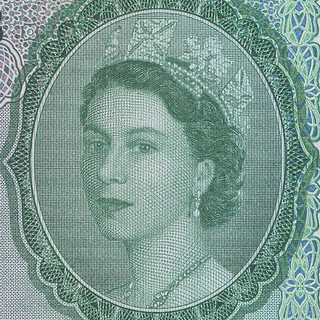 Elizabeth the Second,
Elizabeth the Second,
by the Grace of God, of the
United Kingdom of Great Britain and Northern Ireland
and of Her other Realms and Territories Queen,
Head of the Commonwealth,
Defender of the Faith
At the time of writing, Her Majesty The Queen is the third longest reigning monarch in history. Her 70 year reign has seen some of the greatest societal, cultural and technological changes in human history. It is widely believed that hers may be the most recognised face on the planet, and a small part of that is because she has appeared on the banknotes of more nations, and for a longer period of time, than any other living person.
The first pages of this catalogue detail the principle portraits of The Queen that have appeared on banknotes all over the world between 1952 and the present day. Aside from the obvious interest in seeing the sheer number of portraits that have been used (there are over 30 in all, 26 of which appear here), these page show what 70 years really means in this context. In the earliest images The Queen appears fresh faced and beautiful, and in some cases barely regal at all, as the artists and engravers of the era struggled to decide how best to represent a young, female sovereign. In the later, far more stately images, The Queen is of course older, but now undeniably regal. The final portrait, also shown on the cover of this catalogue, is inspired by the remarkable artwork created by Chris Levine. The original work is entitled Equanimity, a word meaning calm and composed, even while under stress or difficulty.
This auction falls just before the Platinum Jubilee itself, and is our way of marking the occasion. We know that you will share our joy in celebrating 70 remarkable years on the throne for our Queen. Noonans especially wishes to thank Pablo Hoffman, Managing Consultant, for Nuevo Mundo World Paper Money, New York City for his contributions to the auction.
We wish all of you the very best of luck with your bids,
Andrew, Thomasina, Mike and Barnaby
For more information, see:
https://www.noonans.co.uk/
To read the earlier E-Sylum articles, see:
NOONAN'S PLATINUM JUBILEE BANKNOTE AUCTION
(https://www.coinbooks.org/v25/esylum_v25n21a17.html)
PLATINUM JUBILEE BANKNOTE AUCTION SELECTIONS
(https://www.coinbooks.org/v25/esylum_v25n21a18.html)
THE HERITAGE LII COLLECTION CURRENCY SALE
Heritage is offering a significant paper money collection in their upcoming June 12, 2022 sale. Here's a selection of highlights. -Editor
Over Three Centuries in Unreserved Showcase Auction
An eclectic offering of rare currency and related financial documents will be presented
June 12, 2022, in an unreserved, 285-lot, special online Showcase Sale by Heritage
Auctions. The LII Collection's focus on artistic merit and historical significance enhances
each piece's collectability. Spanning over three centuries, the Collection forms a narrative
from the early 1574 Siege of Leiden paper coins
to United States National Banknotes.
American Obsolete Banknotes, representing multiple topics and locations collected
across three decades, feature a number of notes never cataloged by Heritage. Many of the
vignettes, with themes such as architecture, whaling, and polar exploration, are displayed
on great rarities in excellent condition. Included is a significant selection of Gem
Obsolete Banknote Proofs. Additionally, there are rare and historical certificates
engraved by the banknote companies as well as a compact offering of American Colonial
Currency.
Some highlights include:
Maryland July 26, 1775 $1 2/3 Fr. MD-74 PMG Choice Fine 15 Net.
– The
Allegorical' or
Gunpowder
notes from Maryland are among the most ornate of the
Colonial issues, and they circulated heavily. This example is boldly printed and well
margined. Lot 94016.
To read the complete lot description, see:
Maryland July 26, 1775 $1 2/3 Fr. MD-74 PMG Choice Fine 15 Net.. ...
(https://currency.ha.com/itm/colonial-notes/maryland-july-26-1775-1-2-3-fr-md-74-pmg-choice-fine-15-net/a/62244-94016.s)
Marblehead, MA - Marblehead Bank $10 18__ MA-805 G180a, Whitman 2145-010- G240 Proof PCGS Very Choice New 64PPQ, 4 POCs. – An amazingly life-like rendering of John Paul Jones brandishing his sword appears at the center of this exceedingly rare Proof. It is among several Massachusetts rarities from coastal locations. Lot 94108.
To read the complete lot description, see:
Marblehead, MA - Marblehead Bank $10 18__ MA-805 G180a, Whitman 2145-010-G240 Proof PCGS Very Choice New 64PPQ, 4 POCs.
(https://currency.ha.com/itm/obsolete-banknotes/marblehead-ma-marblehead-bank-10-18-ma-805-g180a-whitman-2145-010-g240-proof-pcgs-very-choice-new-64ppq-4-pocs/a/62244-94108.s)
Nantucket, MA - Manufacturers & Mechanics Bank $3 Dec. 5, 1843 MA-845 G18
SENC, W-2270-003-G100 PMG Very Fine 20. – The Moby Dick
imagery selected for this series of notes is most appropriate. There are few examples outside museums
with the vignette, and the condition is likely the finest in private hands. Lot 94109.
To read the complete lot description, see:
Nantucket, MA - Manufacturers & Mechanics Bank $3 Dec. 5, 1843 MA-845 G18 SENC, W-2270-003-G100 PMG Very Fine 20.. ...
(https://currency.ha.com/itm/obsolete-banknotes/nantucket-ma-manufacturers-and-mechanics-bank-3-dec-5-1843-ma-845-g18-senc-w-2270-003-g100-pmg-very-fine-20/a/62244-94109.s)
Jersey City, NJ - Bank of Jersey City $100 18__ NJ-250 G18a SENC, Wait 872 Proof PCGS Gem New 65PPQ, 8 POCs. Riveting red security features complement the gorgeous layout of this unique Gem Jersey City Proof. Lot 94128.
To read the complete lot description, see:
Jersey City, NJ - Bank of Jersey City $100 18__ NJ-250 G18a SENC, Wait 872 Proof PCGS Gem New 65PPQ, 8 POCs.. ...
(https://currency.ha.com/itm/obsolete-banknotes/jersey-city-nj-bank-of-jersey-city-100-18-nj-250-g18a-senc-wait-872-proof-pcgs-gem-new-65ppq-8-pocs/a/62244-94128.s)
Philadelphia, PA - Benjamin Millard, Sign of the White Bear
12-1/2¢ at my Bar
21st Nov. 1814 Hoober 305-UNL PMG Choice Fine 15.
– One of several arctic-themed
notes from the Collection. The uniquely styled polar bear floating on his personal ice floe
was engraved by William Kneass, later Chief Engraver at the U.S. Mint. The only
example known, this note was last auctioned in 2006. Lot 94226.
To read the complete lot description, see:
Philadelphia, PA - Benjamin Millard, "Sign of the White Bear" 12-1/2¢ "at my Bar" 21st Nov. 1814 Hoober 305-UNL PMG Choice Fi...
(https://currency.ha.com/itm/obsolete-banknotes/philadelphia-pa-benjamin-millard-sign-of-the-white-bear-12-1-2-at-my-bar-21st-nov-1814-hoober-305-unl-pmg-choice-fin/a/62244-94226.s)
This important sale, featuring 285 lots, will be auctioned online on Sunday, June 12, 2022, commencing at 6:00 PM Central Time (7:00 P.M. Eastern). For further sale information contact Susan Bremer at SusanB@HA.com. Lot viewing is available by appointment only at Heritage's Office in Dallas; contact Jose Berumen at JBerumen@ha.com or 214-409-1299. All lots are currently on view and open for bidding now at ha.com/62244.
NUMISMATIC NUGGETS: MAY 29, 2022
Here's a selection of interesting or unusual items I came across in the marketplace this week. Tell us what you think of some of these. -Editor
1969 Apollo 11 Commemorative Moon Landing Medal. By Medallic Art Company. Gold. Awarded to Edwin E. Aldrin. Mint State.
Though we are unaware of the specific ceremony in which this medal was awarded to Aldrin, there is no doubt this was a special presentation piece. The case references Aldrin, and the gold composition is clearly something special. Designed by Ralph J. Menconi, the Medallic Art Company manufactured these medals in sterling silver (limited to 10,000 pieces) and bronze (open edition) and both are easily obtainable on the secondary market today. We have never encountered one in gold, however, and have unable to locate any other examples though we strongly suspect identical examples were awarded to Armstrong and Collins.
Wow - great item! In the Stack's Bowers June 2022 Auction. -Editor
To read the complete lot description, see:
1969 Apollo 11 Commemorative Moon Landing Medal. By Medallic Art Company. Gold. Awarded to Edwin E. Aldrin. Mint State.
(https://auctions.stacksbowers.com/lots/view/3-WUOSQ/1969-apollo-11-commemorative-moon-landing-medal-by-medallic-art-company-gold-awarded-to-edwin-e-aldrin-mint-state)
PS639a*
£1
Proof
1.3.1932
H 0316/1000
i/a
AUNC
£230
This colorful proof note is from Pam West's A Bank Note Affair Newsletter 199. -Editor
To visit Pam's website, see:
http://britishnotes.co.uk/
A new thriller about the founding of the third-party grading industry. -Editor
To read the complete item description, see:
SLAB HAPPY
PRATHER, RICHARD S.
(https://www.abebooks.com/servlet/BookDetailsPL?bi=31196837138)
HELMETS ON ANCIENT GREEK COINS
Steve Benner published an interesting article on CoinWeek about helmets on ancient Greek coins. Here's an excerpt - see the complete article online. It's very educational to see images of actual helmets alongside coins picturing them. Thanks! -Editor
Figure 3 shows a Corinthian stater with Athena wearing a decorative Corinthian helmet on the reverse. Note that the helmet is pulled back on the head to allow the face to be seen. The engravers didn't want to cover up who was being depicted on the coin.
In fact, it is very hard to find a coin in which the helmet is pulled down. One well-known example is the diobol of Mesambria, Thrace (Figure 4). The obverse has a Corinthian helmet facing forward and clearly shows how intimidating the sight of a soldier wearing this helmet can appear.
The Boeotian helmet was developed in the fourth century mainly as a cavalryman's helmet because it gave a very good field of view. It is designed as a folded-down cavalryman's hat and was usually made of iron, though bronze ones were also made. It is mentioned by Xenophon in one of his treatises as a good helmet for cavalrymen. This and the Corinthian helmet are the only helmets known by their actual ancient name. The Boeotian helmet had a rounded dome and a frill around the bottom that provided a visor in front and a neck cover in the back. Some had prominent brow ridges or pointed tops, and cheekpieces could be added.
Figure 8 shows a Baktrian tetradrachm with Eukratides wearing a Boeotian helmet on the obverse and cavalrymen on the reverse. This was common on Baktrian coins, but aside from these, the helmet is not shown on many coins.
To read the complete article, see:
Helmets on Ancient Greek Coins
(https://coinweek.com/ancient-coins/helmets-on-ancient-greek-coins/)
RARE MEXICAN SILVER PATTERN COIN SURFACES
In an article for CoinWeek, Louis Golino discusses a rare Mexican pattern coin that recently surfaced in the market. Here's an excerpt- see the complete article online for more. -Editor
A coin collector and part-time dealer named Adrian Coro, who specializes in circulating Mexican coinage, recently made the find of a lifetime when he came across a Mexican 1947 silver 50 centavos coin that numismatists did not think even existed.
The piece is so rare that officials from the Banco de Mexico, which oversees the mint, said they have never seen an example, and it is not part of their legendary collection of Mexican coins that rivals the Smithsonian's collection of American coins in its completeness. The piece is believed to be what collectors like to call one of one
, or unique.
After purchasing it as part of a large collection of Mexican coins from someone who had been a serious collector from the 1950s to the '70s, Coro submitted it to NGC for grading while attending the FUN Show in January 2022.
When it came back, NGC said it was a silver pattern piece that grades MS64 and noted the left-facing bust of 19th-century Mexican political leader Benito Juarez on the coin's reverse. There are also inscriptions for 50 Centavos
; 7 gr.
for 7 grams
; 0.500
, the silver fineness; Mo
for Mexico
; and 1947
.
A check of the Krause Standard Catalog of World Coins, 1901 to 2000 turns up a similar pattern – a 1 Peso silver coin from 1947 that is described as having the same design combination as the piece in question that is valued at $2,600 in the 2015 edition. But there is no reference to a 50 Centavos silver pattern from 1947 with that design. The only pattern 50 Centavos from this period is from 1945, but that one was made of copper-nickel and valued at $1,350 in the same edition.
Coro grew up in Puerto Rico and Florida and began collecting coins with his father, a Cuban exile, at age six. After collecting the coins of Puerto Rico, he moved on to Mexican coins and is very close to finishing a complete set from 1905 to date. He calls himself an old school
collector who is only interested in coins that circulated and does not collect silver Libertads, which he sees more as medals or perhaps bullion since they do not carry a denomination.
He believes that because his pattern – which, amazingly, he said had been tossed aside
as nothing special when he found it in a large collection — has apparently never been seen before and because it could be unique, it is likely one of the rarest Mexican coins of at least the 20th century, if not further back.
To read the complete article, see:
The Coin Analyst: Extremely Rare Mexican Silver Pattern Coin Surfaces
(https://coinweek.com/world-coins/the-coin-analyst-extremely-rare-mexican-silver-pattern-coin-surfaces/)
THE WHOLE TRUTH ABOUT THE PAGET ‘MODELS'
Richard Lobel of CoinCraft in London submitted these remembrances about the Paget Models. Thank you! -Editor
I saw in a recent Spink E-Auction a listing of the T H Paget reverse model of the 25 New Pence for the Silver Wedding of Her Majesty Queen Elizabeth II and Prince Philip. I found it long and interesting and to be honest on many parts incorrect. But what the collecting fraternity has grown to accept, not the actual facts. I know it was wrong because I struck them!
This is the true story of the Paget Models for Great Britain (Unusual World Coins by Colin Bruce published by Krause X-TS1), New Zealand (unlisted, as we didn't figure out to later that it could only be New Zealand), Bolivia (X-TS1), Uruguay (X-TS1, 2, 3 4) (one of these metals does not exist) and British Caribbean Territories (X TS1). At the time I tried to do everything correctly, but over the years the truth has become obscured, as it has been with many private issues. I am going to try and straighten everything out with this piece; they are still very collectable pieces but the information is generally wrong. They were engraved by Paget just not struck by Paget or the Royal Mint.
Years ago Christies Auction House in London offered five large plasters of pieces that T H Paget had made as presentation purposes for new coins. But they were not accepted. I bought all five plasters at that auction and as usual, just put them in one of our vault rooms and forgot about them. A number of years later I decided that it would be most interesting to do something with the plasters. I spoke with Raphael Maklouf who owned Tower Mint. He had struck a lot of coins and medals for us over the years. Business was rather slow for him, at the time and as we had done a lot of business together, he agreed to make dies from the plasters and strike crownsized pieces for me. After all his machinery was on hand to make dies from plasters, that was of course was one of his main businesses at the time.
To insure that there would be no fear of anyone thinking they were struck by the Mint, I insisted that the reverse read just ‘Model'. He made the dies and struck the pieces as per my requirements. He supplied the goldine and the cupro-nickel blanks and I supplied the silver blanks. A couple of years before I had purchased 999 silver blanks from a silver manufacturer in the United States. It was cheaper to buy blanks from them than to buy blanks in this country. I had them in stock for a couple of years and it felt it was the quickest way to use up stock that we had on hand was to strike something. I struck 150 of each in cupro-nickel, 150 in goldine and 50 in 999 fine silver.
I sold the entire mintage of the Prince Philip 25 New Pence, excluding only a small number of trials, to the late Richard Nelson of the Money Company in California. I sold the entire George VI New Zealand Dollar issue to the late Bob Roberts of M. R. Roberts of Sydney Australia. The Bolivia and Uruguay I sold parts to a number of dealers, to be honest it was a long time and millions of sales ago. The British Caribbean issue never really sold as it was an error, a tiny coin blown up on a very large planchet. Over the years I have sold them to my own collectors one by one, today we have a very few of the base metal pieces left. And I think we sell them for about £ 24 each. We use to charge less, but the smaller the number we have in stock the more we ask for what remains.
The Royal Mint did speak to Raphael and asked him about these pieces. He denied knowing anything about them. The Mint said that's what they thought because of the strange mixture of the silver, it was too high quality and not a metal he used. Raphael then called me all in a tizzy. He said that he had taken the dies and blasted the design off. I objected as I had paid for the dies but was done was done. Shortly afterwards we stopped dealing with Tower Mint entirely. We found that they had been using other of our dies that we had paid for and owned, to strike medals that they were then selling through stately homes.
Our pieces were struck as samples or models there was never any intention to mislead the collectors. What the people did with the pieces they bought was beyond my control. They are beautiful pieces and they were designed and engraved by Paget only they were struck by Richard Lobel. I find that things I have struck over the years have become more accepted to collectors as time goes by. In the old days perhaps more private issues were struck than today, but they have had time to age, mature and be appreciated.
In 1965 I struck as part of a 3 way partnership, my first coin, the 1965 Cuban Souvenir Peso. They were struck in silver by ‘Louis of Fulton St' and I believe the retail price was $12.50 and the wholesale per hundred was $7.50. A very serious friend / collector in NYC tells me that they are now being slabbed and selling for as much as $1,000 at auction. Now about the other 350 items I have struck...
To read the complete SPINK lot descriptions, see:
https://www.spink.com/lot/21171009121
https://www.spink.com/lot/21171009122
https://www.spink.com/lot/21171009123
https://www.spink.com/lot/21171009124
https://www.spink.com/lot/21171009125
THE BOOK BAZARRE
FRASER'S WASHINGTON TURNS BACK ON GOD!
For grins I'll occasionally click a headline with an odd take on a numismatic topic. Here's one titled "Fact Check: Do New US Quarters Have George Washington Turning His Back on 'In God We Trust?'" -Editor
 Through all the major changes the quarter has gone through — first transitioning from being made of a 90% precious metal alloy to a comparatively worthless cupronickel-coated copper coin in 1965, then a replacement of the eagle on the reverse for a series of new designs including states, parks, and national landmarks — the image of Washington on the coin's obverse has remained virtually unchanged.
Through all the major changes the quarter has gone through — first transitioning from being made of a 90% precious metal alloy to a comparatively worthless cupronickel-coated copper coin in 1965, then a replacement of the eagle on the reverse for a series of new designs including states, parks, and national landmarks — the image of Washington on the coin's obverse has remained virtually unchanged.
Now, the unforgettable design of our first president is being tossed out of the window for something entirely new in 2022, a revision that seemingly has the founding father turning his back on our national motto, In God We Trust.
The most notable change on the coins is the removal of the old depiction of Washington.
In its place is an alternate design proposed by Laura Gardin Fraser for the quarter in 1932, where a noticeably blockier Washington faces right instead of left.
Fraser's design is not completely new to American coinage; her right-facing Washington graced a 1999 gold commemorative coin issued by the U.S. Mint.
As many have noticed with the new portrait, the reversal of direction also appears to have George Washington literally turning his back on the In God We Trust
his portrait normally faces:
When comparing the old quarter design to the new, it seems clear that Washington was re-positioned with his back to the God-referencing motto.
Whether that has any symbolic meaning to the designers of the new version is anyone's guess.
There have always been bizarre rumors about U.S. coin designs, such as the one about the initials "J.S." somehow standing for "Joseph Stalin." The Internet memorializes and perpetuates them as part of content mills that profit by drawing those inclined to believe such nonsense to the ads on their pages. -Editor
To read the complete article, see:
Fact Check: Do New US Quarters Have George Washington Turning His Back on 'In God We Trust?'
(https://www.westernjournal.com/fact-check-new-us-quarters-george-washington-turning-back-god-trust/)
REPORT: REMOVE CHIANG KAI-SHEK PORTRAITS
Coin design changes are afoot in Taiwan; this Taipei Times article discusses a new commission report calling for removing Chiang Kai-shek from coins and paper money. -Editor
Chiang Kai-shek should be removed from Taiwanese banknotes and coins, the Transitional Justice Commission said in its final report as the ministy-level organization prepares to close tomorrow.
Chiang's likeness should be removed from coins and notes when the central bank carries out a redesign of the nation's currency, said the report, an official copy of which was handed to Premier Su Tseng-chang by the commission's acting minister Yeh Hung-ling at a ceremony in Taipei on Friday.
Images of Chiang are on NT$1 and NT$5 coins, and NT$200 banknotes.
Citing the findings of two expert panels that the commission organized in 2019, the report said the purpose of currency design is to promote symbols and values that unify the nation and represent it to the outside world.
The prominence of Chiang and Sun Yat-sen on money suggests an overemphasis on political leadership and the glorification of strongmen,
which is at odds with democratic norms, it said.
Putting Chiang on coins and banknotes implies that an authoritarian ruler is the nation's unifying symbol and that his regime represents its values, the report said.
Coins and banknotes bearing Chiang's image should be taken out of circulation and replaced with new designs to be selected via an appropriate process that enables civic participation, the report said.
Unlike say, China. -Editor
To read the complete article, see:
Take Chiang off cash: commission
(https://www.taipeitimes.com/News/front/archives/2022/05/29/2003778961)
PRINCE WILLIAM TO APPEAR ON £ 5 COIN
The Royal Mint has announced a new coin for Prince William's 40th birthday. Here's an excerpt from an article in The Telegraph. -Editor
The Duke of Cambridge's 40th birthday will be celebrated with a £ 5 coin featuring his portrait, the Royal Mint has announced.
The UK's official coin producer has unveiled the coin ahead of Prince William's milestone birthday on June 21.
It is the first time the Duke, who is second in line to the throne, will appear alone on an official UK coin struck by the Royal Mint.
The coin's depiction of Prince William appears to be based on a photo taken at the Queen's Birthday Party in June 2018, at the UK Ambassador's residence in Amman, Jordan.
The commemorative piece has been crafted by engraver Thomas T Docherty and shows the Duke in a three-quarter profile gazing up to the top right of the coin, with the number 40 to his left and his royal cypher "W" to his right.
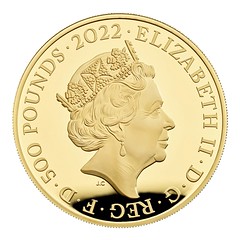 Queen Elizabeth II's image, engraved by Jody Clark, will be struck on the other side of the coin.
Queen Elizabeth II's image, engraved by Jody Clark, will be struck on the other side of the coin.
There will also be an inscription on the edge reading: "HRH The Duke of Cambridge."
Prince William has previously only appeared on an official UK coin accompanied by the Duchess of Cambridge, issued in 2011 to commemorate the couple's marriage.
Mr Docherty said the coin's design "strikes a balance between the fresh energy of His Royal Highness being a young dad with the ceremonial nature of his royal position".
He added: "A three-quarter angle of the portrait creates a more dynamic portrait rather than a traditional side-on profile.
"I used certain clay sculpting techniques on a digital platform to achieve the style needed for the design, to translate effectively from two to three dimensions."
To read the complete article, see:
Prince William to appear on £ 5 coin to mark his 40th birthday
(https://www.telegraph.co.uk/royal-family/2022/05/23/prince-william-will-appear-5-coin-mark-40th-birthday/)
Nice work. In numismatics though, no good deed goes unpunished. It didn't take naysayers long to start picking on the design, although I do think they have a point. Here's an excerpt from (where else?) the Daily Mail. -Editor
It is the first time the Duke of Cambridge, who is second in line to the throne, will appear alone on an official coin struck by the Royal Mint.
But eyebrows have been raised among social media users over the portrait, with some saying the Royal Mint has been generous with the Prince's hairline.
One Twitter user wrote: 'The £ 5 coin to mark Prince William's 40th birthday has more hair than he does!'
Another Twitter user said: 'They must have used a very old photo for his image the coin, he hasn't had that much hair for many a year!'
They wrote: 'I love Prince William, but sorry, that coin looks more like Lord Voldemort before his hair loss.'
But yet, why not picture a somewhat younger Prince with a little more hair? Is that so wrong? -Editor
Meanwhile, royal author Phil Dampier told The Sun that William was likely to be 'pleased' with the coin as 'they've given him more hair'.
'He looks younger than 40 so he won't complain. He looks thoughtful but also like he's looking for inspiration, which he will need in coming decades.'
To read the complete article, see:
'Where did that thick mane come from!?' Social media users mock Royal Mint's £ 5 coin featuring 3D portrait of Prince William that appears to show full head of hair
(https://www.dailymail.co.uk/news/article-10848625/Twitter-users-say-Royal-Mints-5-coin-featuring-Prince-William-hair-brushed.html)
"Did you give me hair?"
In an earlier E-Sylum article we heard former U.S. Mint Sculptor-Engraver Don Everhart discuss his conversation with the Dalai Lama about his design for the Congressional Gold Medal. -Editor
 The CGM Ceremony was held in the Capitol Rotunda in February of 2007. Several members of the Mint staff were invited to meet with His Holiness in his hotel suite before the ceremony. My boss, John Mercanti, and Ed Moy, the Director of the Mint, accompanied us to the much-anticipated meeting. It was THE hot ticket!
The CGM Ceremony was held in the Capitol Rotunda in February of 2007. Several members of the Mint staff were invited to meet with His Holiness in his hotel suite before the ceremony. My boss, John Mercanti, and Ed Moy, the Director of the Mint, accompanied us to the much-anticipated meeting. It was THE hot ticket!
We all sat in a circle with the Dalai Lama to my immediate left. Everyone spoke briefly to him and when it got around to me I mentioned that I had gotten quite a feeling of serenity when working on this medal, which I directly attributed to him. He leaned forward to speak to me and I expected to hear the secret to eternal happiness. Instead he asked "Did you give me hair?" while brushing the top of his head. I assured him that I did. We all had a laugh and then proceeded to talk about male pattern baldness.
To read the earlier E-Sylum article, see:
DON EVERHART AND THE DALAI LAMA
(https://www.coinbooks.org/v21/esylum_v21n18a23.html)
LADY AND SIR MOSES MONTEFIORE MEDAL
I came across this medal this week, initially for the Numismatic Nuggets article. Looking for more information I found this page from The Edythe Griffinger Portal at the Leo Baeck Institute. It's a Charles Weiner medal from 1864. -Editor
Medal in honor of Sir Moses Montefiore and his wife, Lady Judith.
Recto: Profile portraits of Sir and (half covered) Lady Montefiore, surrounded by text: Judith Lady Montefiore. Sir Moses Montefiore BART. F.R.S.
Signed Ch. Wiener 1864.
Verso: A wreath of shamrock, rose, thistle, palm, oak, and laurel entwining five Hebrew labels naming Jerusalem, Damascus, Russia, Morocco, and Romania, being places of Sir Montefiore's activities. The wreath surrounds part of verse Exodus, 2:11 in Hebrew: "Moses went out to his kinsfolk and witnessed their labors."
Sir Moses Haim Montefiore (1784 – 1885) was a British financier, banker, and philanthropist, born into a Sephardic Jewish family in Livorno, Italy. Montefiore was highly active in supporting Jewish communities in Eastern Europe, North Africa and throughout the Ottoman Empire. He died in Ramsgate, England in 1885.
His wife, Lady Judith, Montefiore, née Barent Cohen (1784 – 1862) was an English linguist, musician, travel writer, and philanthropist. She authored the first Jewish cookbook written in English.
Charles Wiener was the youngest of the three Wiener brothers, who were all medalists active in Belgium. Born in Venloo, Charles studied drawing at the Academy of Fine Arts in Brussels while simulataneously training under his brothers. He then studied under Eugène-André Oudiné in Paris. In 1856 he settled at the Hague, working as an engraver to the king of Holland. After six years, he worked in various cities for short periods of time: from London, where he was deputy engraver at the Royal Mint; and then to Lisbon in 1864 as chief engraver to the Mint of Portugal. Charles returned to Brussels in 1867 and produced medals, some in conjunction with his brother, Jacques. He won a number of awards and decorations for his work in Belgium, London, the Netherlands, Russia, and Sweden.
To read the complete article, see:
Lady and Sir Moses Montefiore Medal
(https://www.lbi.org/griffinger/record/397970)
What initially caught my eye when I saw one of these in an auction listing was what looked to me like a deep counterstamp on the obverse portrait. Curious, I took a closer look. Turns out, it was just the subject's ear. But it illustrates the deep relief on the piece.
I like these photos better. Does anyone have one of these in their collection? -Editor
To read the complete lot description, see:
LADY AND SIR MOSES MONTEFIORE BRONZE MEDAL 1864 ISRAEL
(https://www.invaluable.com/auction-lot/LADY-AND-SIR-MOSES-MONTEFIORE-BRONZE-MEDAL-1864-I-5-c-91641CAAD1)
MEXICAN BANKNOTE'S ENDANGERED SALAMANDER
An endangered salamander pictured on a recent Mexican banknote has generated great interest. -Editor
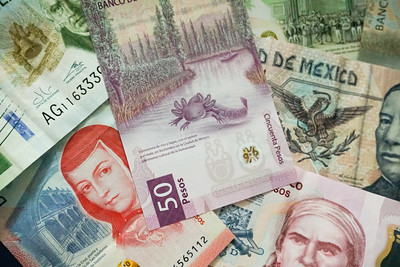 On Oct. 29, 2021, Banco de México, Mexico's central bank, issued a new 50-peso ($2.51) bill, the last in a series of redesigned bank notes intended to combat counterfeiting, facilitate people with visual impairments, and increase the note's longevity.
On Oct. 29, 2021, Banco de México, Mexico's central bank, issued a new 50-peso ($2.51) bill, the last in a series of redesigned bank notes intended to combat counterfeiting, facilitate people with visual impairments, and increase the note's longevity.
While the reverse of the old 50-peso bill featured the famed Morelia aqueduct and monarch butterflies, the new note depicts the axolotl in its natural habitat, among the chinampas and ahuejote trees, a willow species native to Mexico. The decision to feature an axolotl — which many people believe is an axolotl named Gorda, although Banco de México clarified that it used various images for reference — has shone a spotlight on decadeslong efforts to rehabilitate the species.
The bill received the International Bank Note Society's 2021 Bank Note of the Year Award and has caught local imagination to such an extent that online sellers are offering it for as much as 500,000 pesos (approximately $25,000). Rocío Espinoza de los Monteros, a curator at Mexico's Numismatic Society, a collective devoted to studying currency, says people are collecting the bill rather than spending it due to perceived scarcity, although the note is currently in circulation.
We've been getting approximately 1,700 visitors on the weekends, which is great news,
says Pamela Valencia, founder of Museo del Ajolote, in western Mexico City. The museum hosts a colony of 15 axolotls and works to improve the ecosystem to release them into their natural habitat. There have been times when we wouldn't get any.
Paola Vargas, 26, one of the visitors at the Museo del Ajolote, waited with her young son for over 30 minutes to enter the museum. My 7-year-old son saw on TikTok that the axolotl from the bill was here,
she says. He showed me the video, and I told him, ‘We should go see it.'
People of all ages visit the museum, but children seem most keen, Valencia says.
Georgina Ruiz, 48, visited the museum with her spouse and children. We didn't know about the axolotls. We hadn't seen them until they came out on the bills. We found out that they are in danger of extinction,
she says. We can help by coming and contributing a little, spreading the word about the project.
Luis Zambrano, a researcher at the Institute of Biology at the National Autonomous University of Mexico, has studied axolotls for 14 years. Since the rollout of the new note, many have approached him to learn more about the species. A woman in Barcelona, Spain, emailed him, requesting he talk about salamanders at her son's school; a German couple asked him to accompany them to Xochimilco to meet the creatures.
I'm not a travel agency,
says a laughing Zambrano, who decided to connect the couple with a chinampa farmer that participates in his conservation project.
His team has also begun receiving donations from children. It's not a stratospheric amount, but we like it,
he says, because the seed of true environmental education is there, in the next generation, who will probably do more for the conservation of species — in particular, this species.
To read the complete article, see:
Meet the Surprising Star of Mexico's New Bank Note
(https://globalpressjournal.com/americas/mexico/meet-surprising-star-mexicos-new-bank-note/)
LOOSE CHANGE: MAY 29, 2022
Here are some additional items in the media this week that may be of interest. -Editor
CoinWeek has a nice article by Tyler Rossi on the Aes Grave. -Editor
It is said that when Greece was building grand temples of white marble, the Romans were living in mud huts. While this is a sweeping generalization, there is some truth behind it as is demonstrated by the Republic's earliest documented coinage, the Aes Rude or Rough Bronze
. These proto-coins, used between the eighth century BCE and the late fourth century BCE, were basically rough ingots of cast bronze traded based on their base metal weight.
By the early fourth century BCE, as the Roman economy evolved and local metalworking technology became more sophisticated, the Aes Rude slowly transformed into the Aes Grave or Heavy Bronze
. Like the Aes Rude series, the Aes Grave traded at the value of the metal. But unlike the rough bronze ingots, the Aes Grave can be considered true coinage that includes distinctive types as well as marks of value and approximating to a definite weight standard
(Sydenham, 55). While the value of each Aes Grave was still based on weight, interestingly that weight fluctuated wildly. This was due to the fact that the Romans focused more on the total weight of metal and not on the individual coins. Since it was a fractional denomination system based on the roman pound, all the Roman mint was concerned with was casting the correct number of coins from each pound.
To read the complete article, see:
The Aes Grave Bronze Coin During the Roman Republic
(https://coinweek.com/ancient-coins/the-aes-grave-bronze-coin-during-the-roman-republic/)
Here are a couple of items for the bibliophiles among us. Trinity College Dublin has one of the world's greatest libraries, and the building is about to undergo a serious renovation. The photo is some real eye candy. Thanks to Harry Salyards for passing along this New York Times article. -Editor
The Long Room, with its imposing oak ceiling and two levels of bookshelves laden with some of Ireland's most ancient and valuable volumes, is the oldest part of the library in Trinity College Dublin, in constant use since 1732.
But that remarkable record is about to be disrupted, as engineers, architects and conservation experts embark on a 90 million euro ($97 million) program to restore and upgrade the college's Old Library building, of which the Long Room is the main part.
The library, visited by as many as 1 million people a year, had been needing repairs for years, but the 2019 fire at Notre Dame cathedral in Paris was an urgent reminder that it needed to be protected, according to those involved in the conservation effort.
To read the complete article, see:
An Irish National Treasure Gets Set for a Long-Needed Restoration
(https://www.nytimes.com/2022/05/28/world/europe/dublin-trinity-library-restoration.html)
At The E-Sylum we love words as well as the books they come in. Here's an article with a great history of punctuation. Yes, even that had to be invented. While preparing this for tonight's issue I discovered that we'd actually referenced this exact essay a couple years ago. But here goes anyway. If you hadn't clicked the link to see the full article last time, here's another chance. -Editor
 In the broad sense, punctuation is any glyph or sign in a text that isn't an alphabet letter. This includes spaces, whose inclusion wasn't always a given: in classical times stone inscriptions as well as handwritten texts WOULDLOOKLIKETHIS – written on scrolls, potentially unrolling forever. Reasons for continuous script aren't entirely clear, but might be connected to a conception of writing as record of speech rather than a practice in itself, and since we're hardly aware of the minuscule pauses we make between words when speaking, it isn't obvious to register something we do and perceive unconsciously with a designated sign that is a non-sign: blank space.
In the broad sense, punctuation is any glyph or sign in a text that isn't an alphabet letter. This includes spaces, whose inclusion wasn't always a given: in classical times stone inscriptions as well as handwritten texts WOULDLOOKLIKETHIS – written on scrolls, potentially unrolling forever. Reasons for continuous script aren't entirely clear, but might be connected to a conception of writing as record of speech rather than a practice in itself, and since we're hardly aware of the minuscule pauses we make between words when speaking, it isn't obvious to register something we do and perceive unconsciously with a designated sign that is a non-sign: blank space.
One of the primary purposes of writing in Ancient Greece and Rome was giving lectures and political speeches, not publishing texts. Before going on stage, an orator would work on his text, making subjective, individually determined signs for long and short syllables, pauses for rhetorical effect and breathing, and joining up of words when reading aloud. There was no such thing as reading at first sight.
Writing without punctuation lasted for many hundreds of years, in spite of individual efforts such as those of Aristophanes, the librarian at Alexandria.
To read the complete article, see:
A history of punctuation
(https://aeon.co/essays/beside-the-point-punctuation-is-dead
-long-live-punctuation)
To read the earlier E-Sylum article, see:
LOOSE CHANGE: SEPTEMBER 6, 2020 : A History of Punctuation
(https://www.coinbooks.org/v23/esylum_v23n36a32.html)
Jeff Garrett published an article on the NGC site about gauging risk when purchasing coins. -Editor
 If you can buy a great coin, you can almost be certain that another collector in the future will also want that great coin. The key words are: in the future. Never stretch to buy a great coin that you might need to sell relatively soon. You might not quickly find someone who is willing to stretch as you have, and you could be faced with a substantial loss. This comes back to your risk tolerance.
If you can buy a great coin, you can almost be certain that another collector in the future will also want that great coin. The key words are: in the future. Never stretch to buy a great coin that you might need to sell relatively soon. You might not quickly find someone who is willing to stretch as you have, and you could be faced with a substantial loss. This comes back to your risk tolerance.
In general, collectors should make an effort to assess their tolerance for risk when making an investment in rare coins. As with other investments, your timeline for investing is also extremely important. A stock advisor will ask if you are investing money that you might need sometime soon. Obviously, if you might need the funds in the near future, you should avoid risky investments that might drop sharply and will take years to recover. Investing in coins should also be for collectors who think long term.
To read the complete article, see:
Jeff Garrett: Weighing the Opportunities in Coin Collecting
(https://www.ngccoin.com/news/article/10233/)
FEATURED WEB PAGE: AWARDS AND DECORATIONS OF THE US
This week's Featured Web Page is suggested by Paul Horner, who writes:
"Here is a page that shows hundreds of civilian medals and awards of the US government. Scrolling down and clicking on the colored name usually results in a page that describes and shows the medal. There are 100s!"

